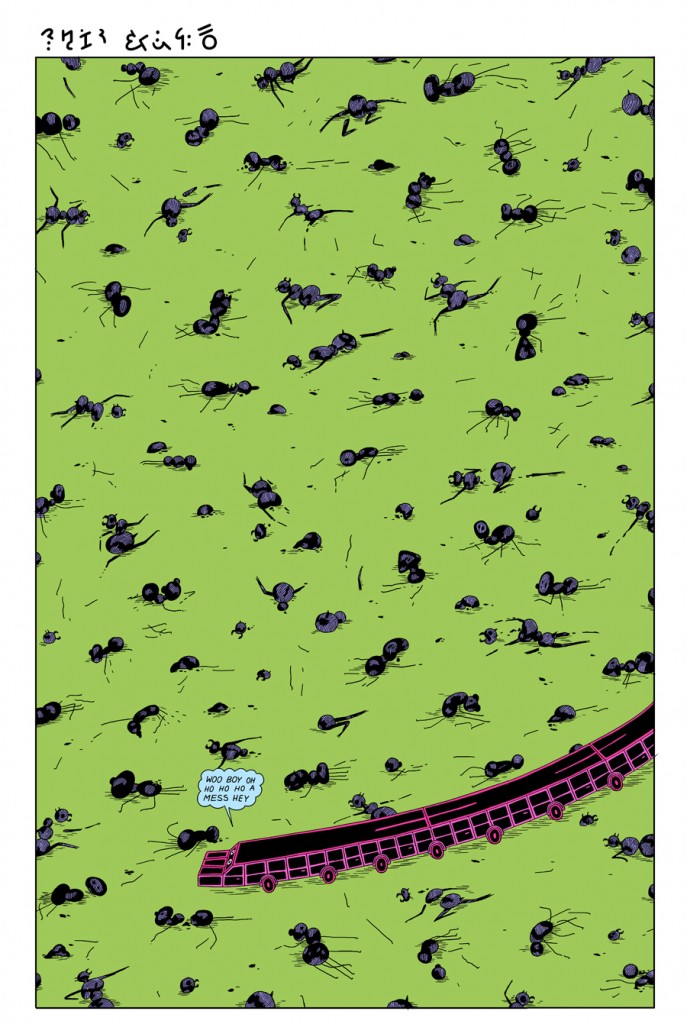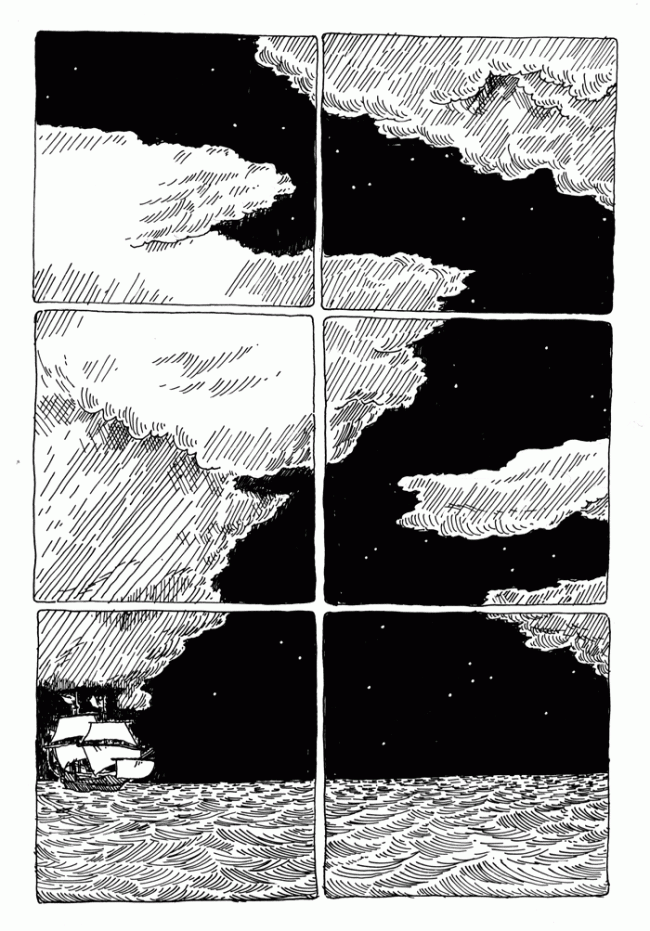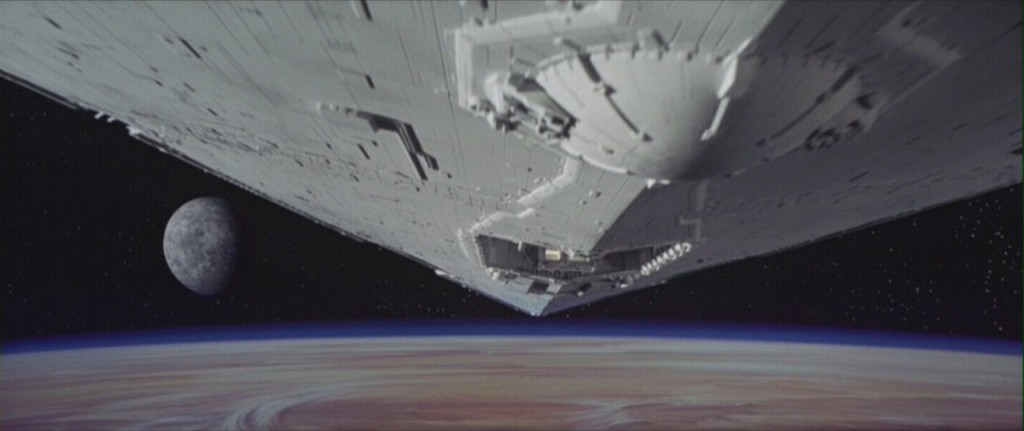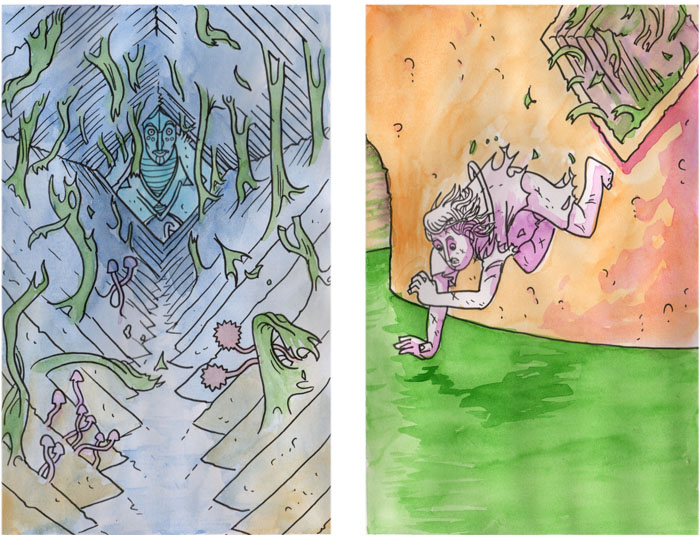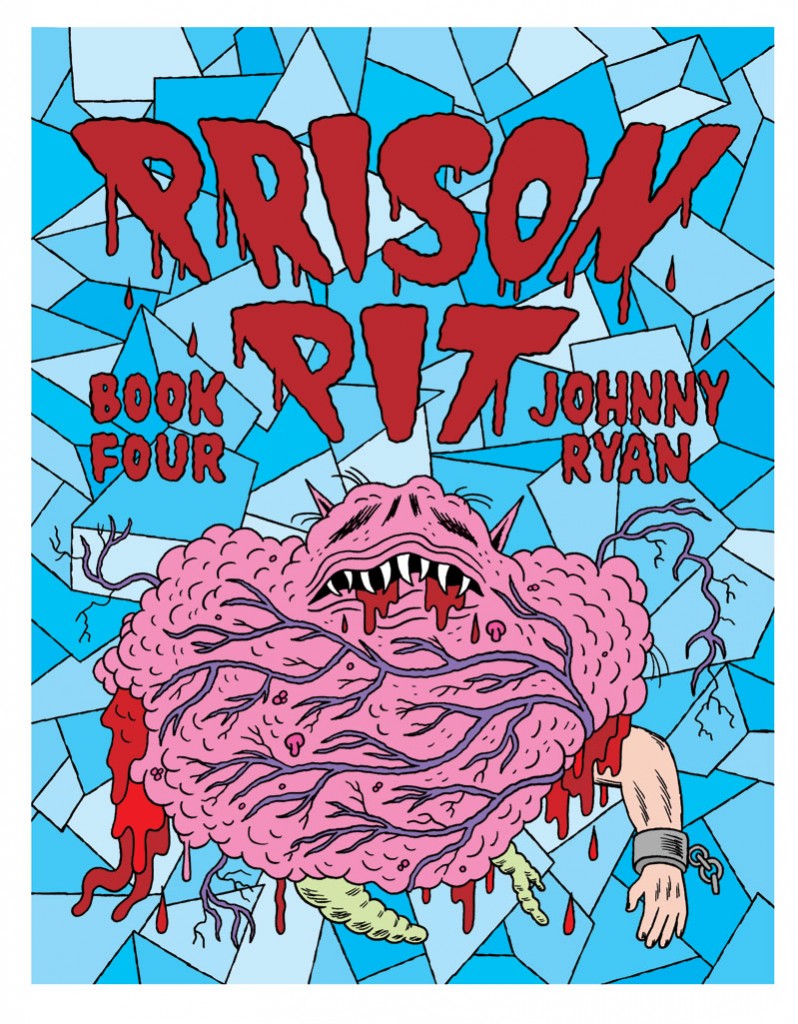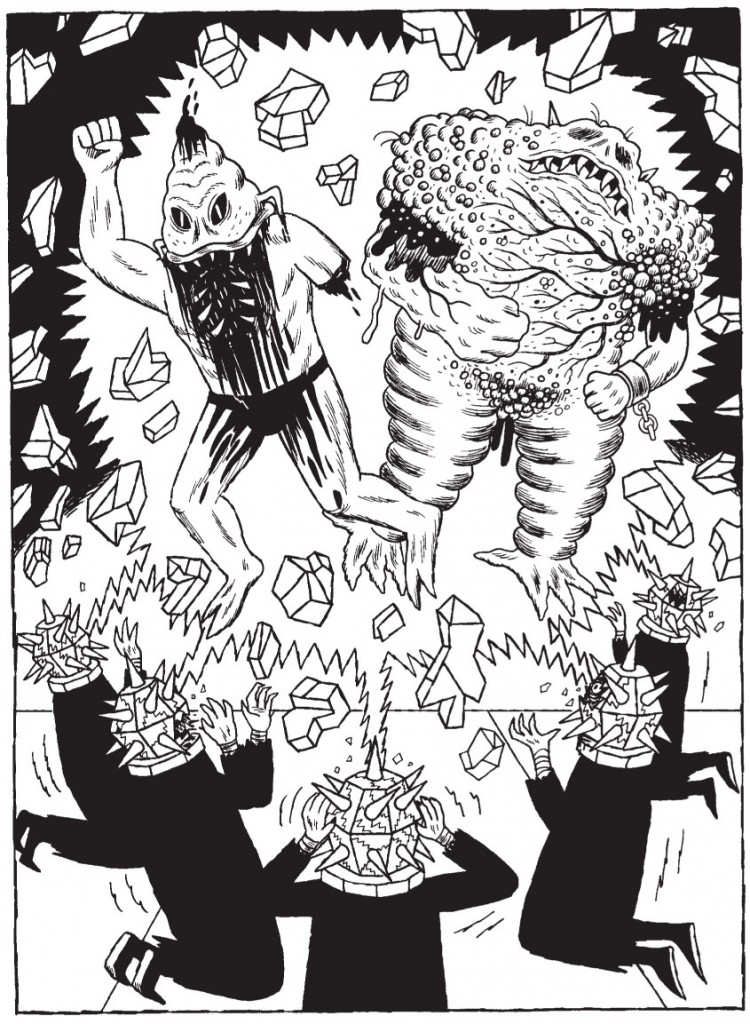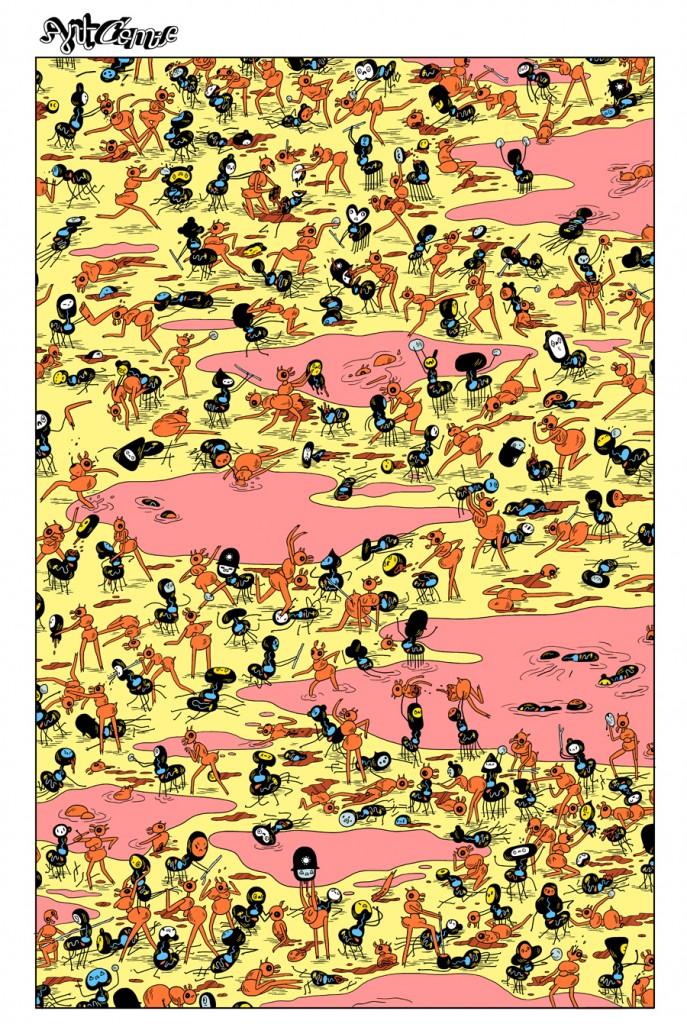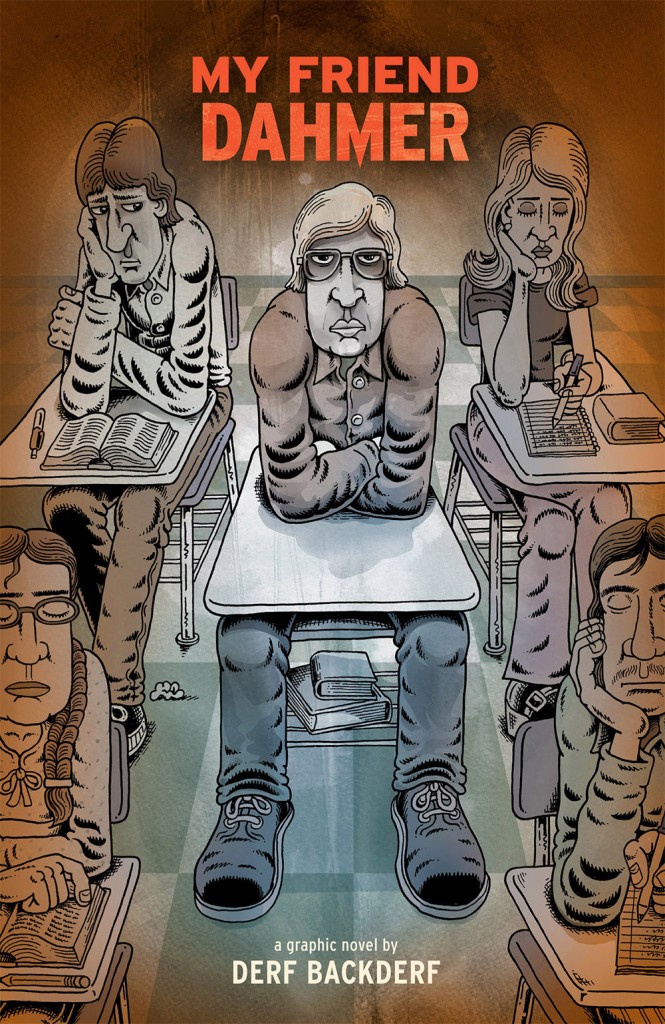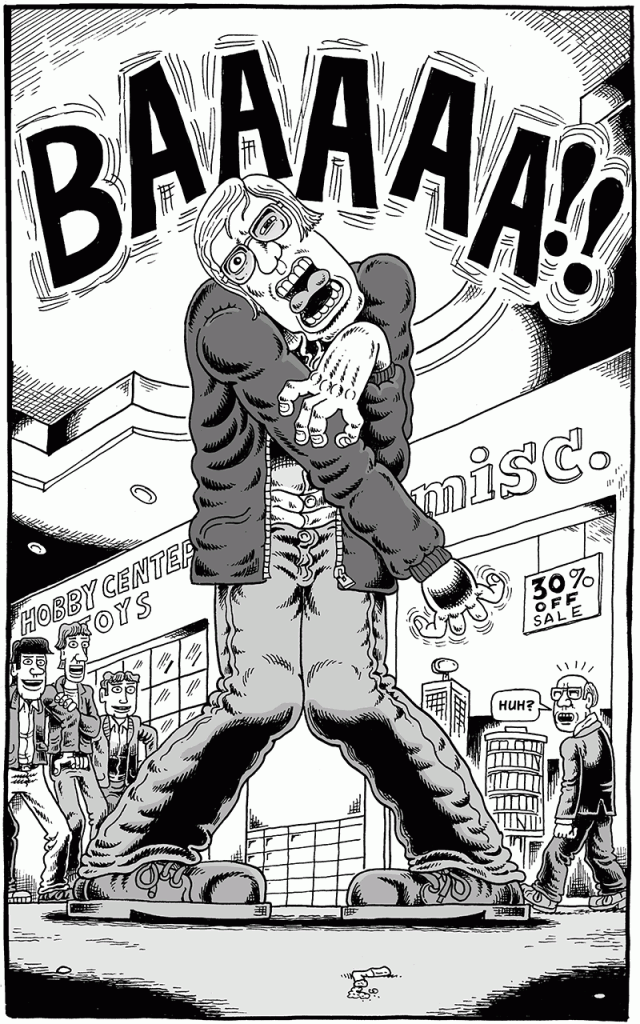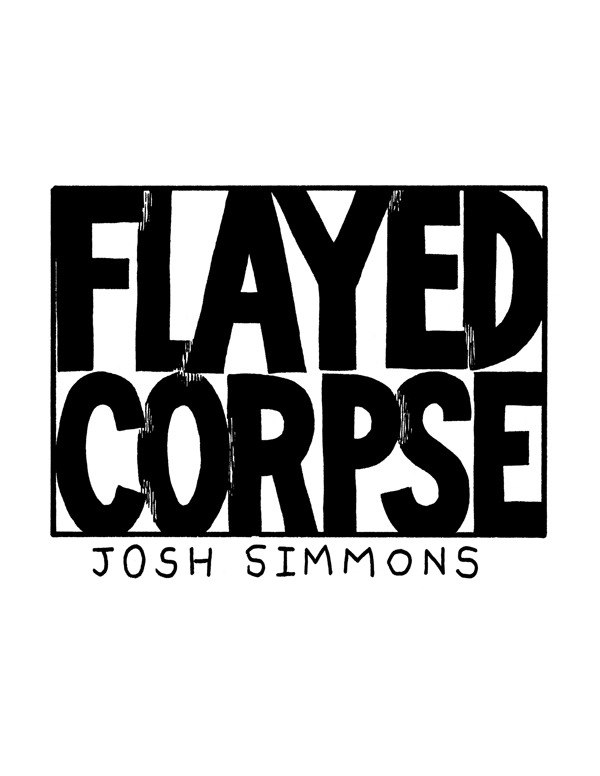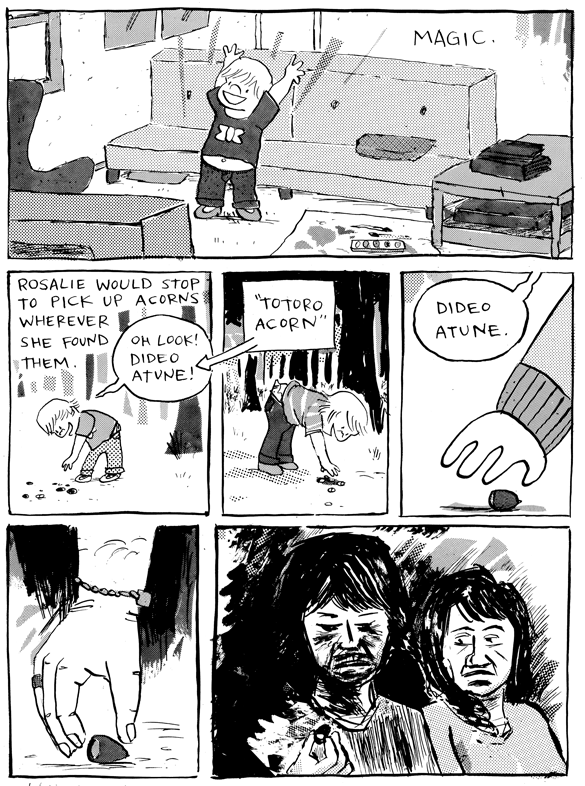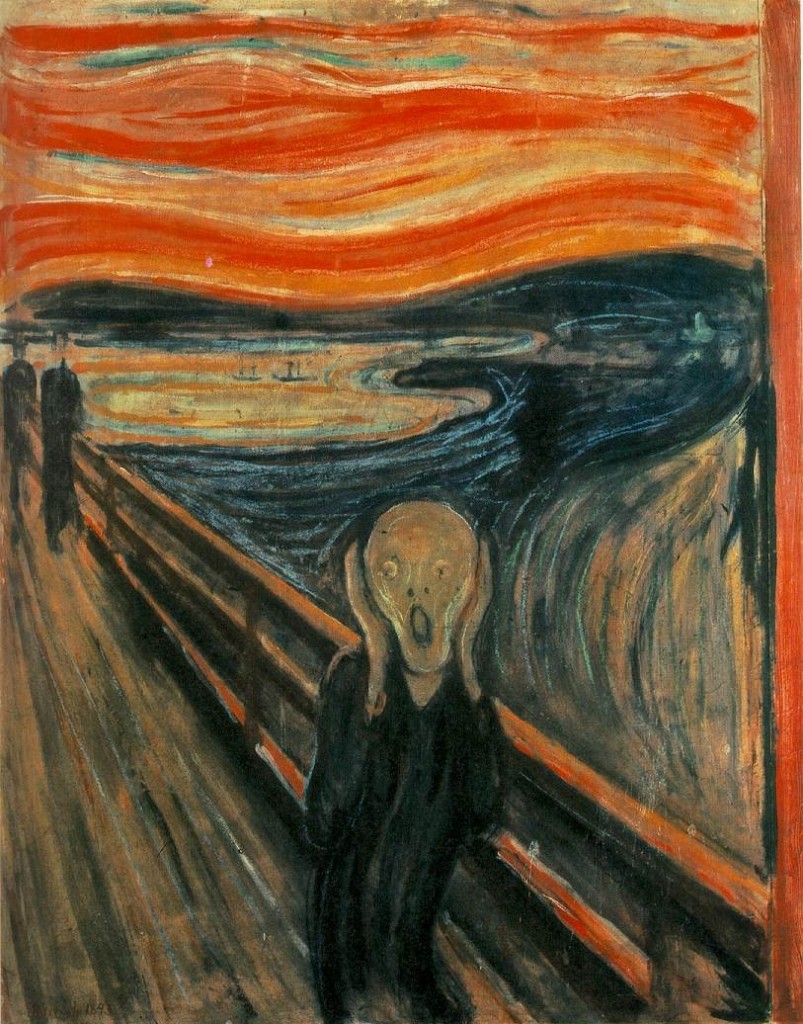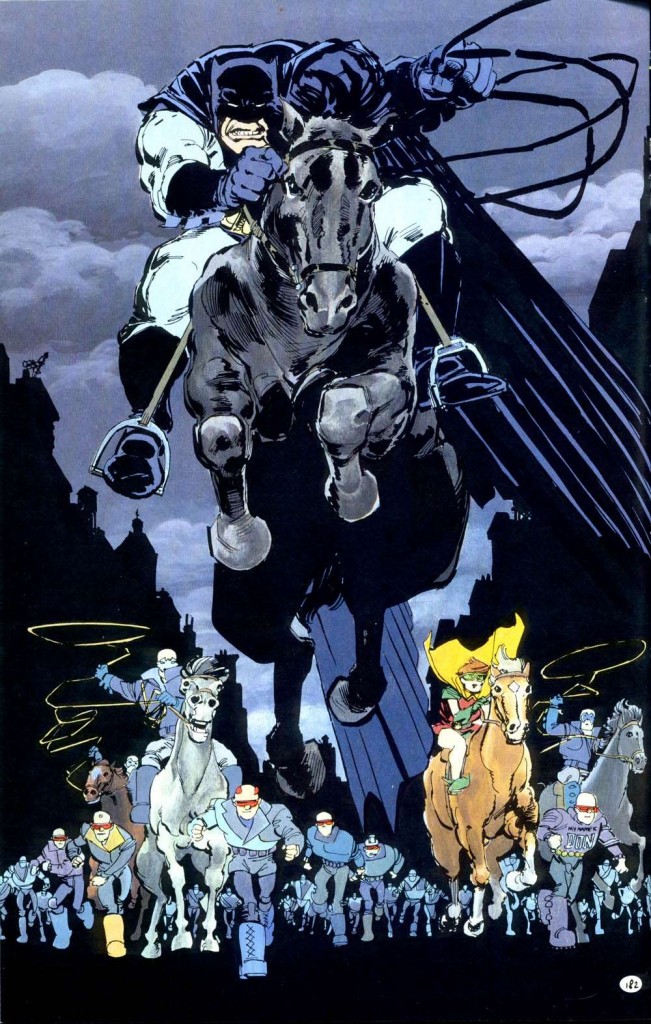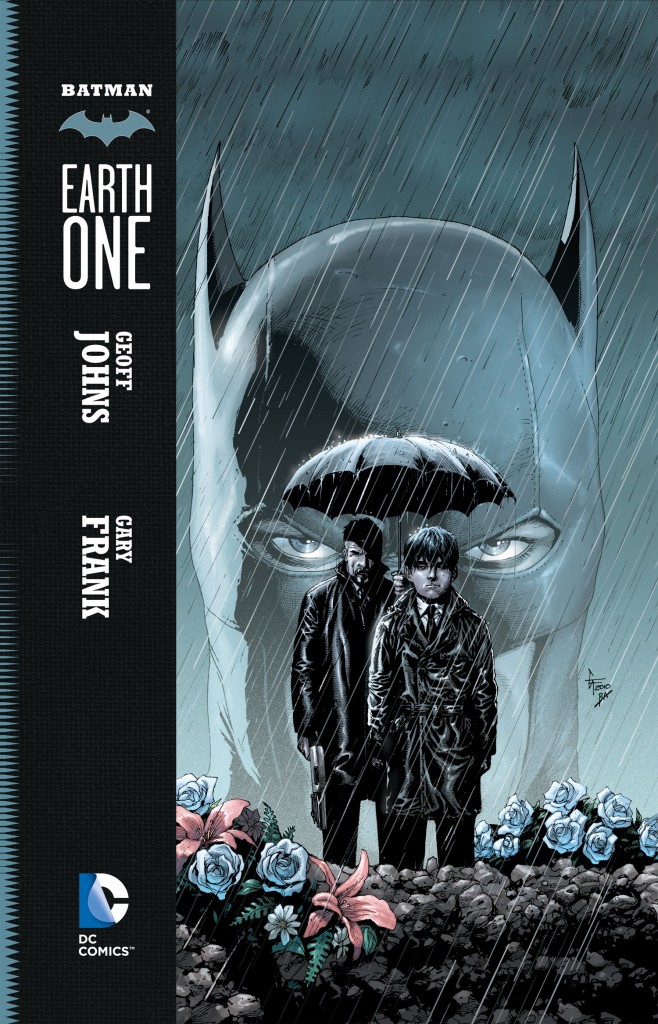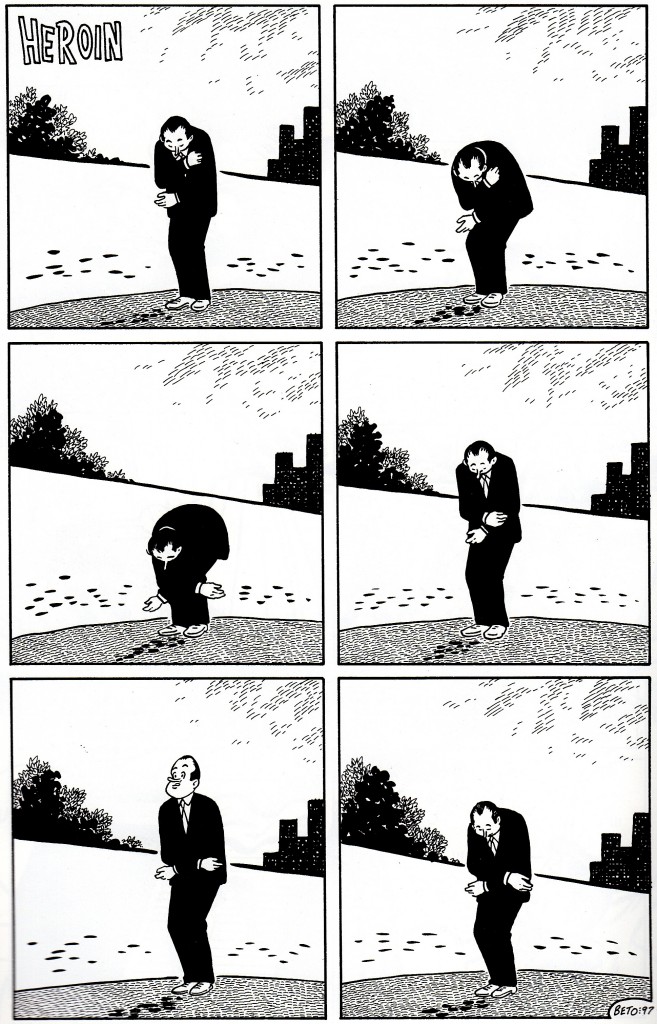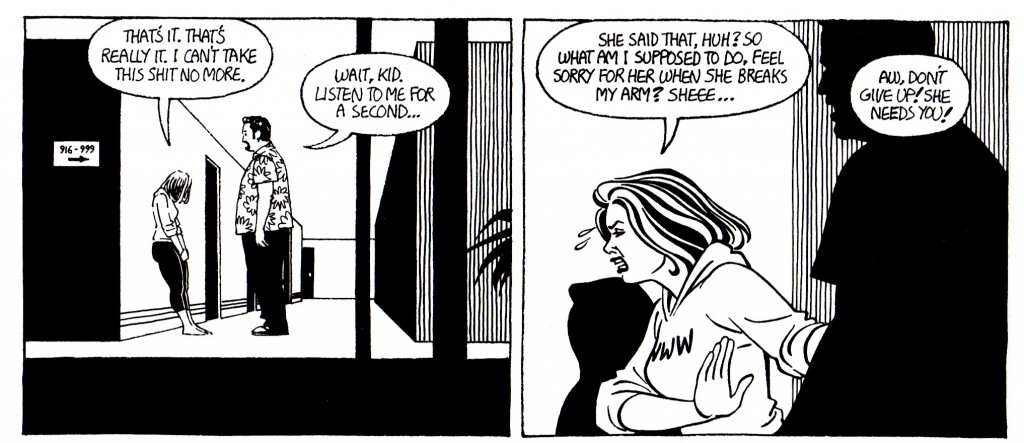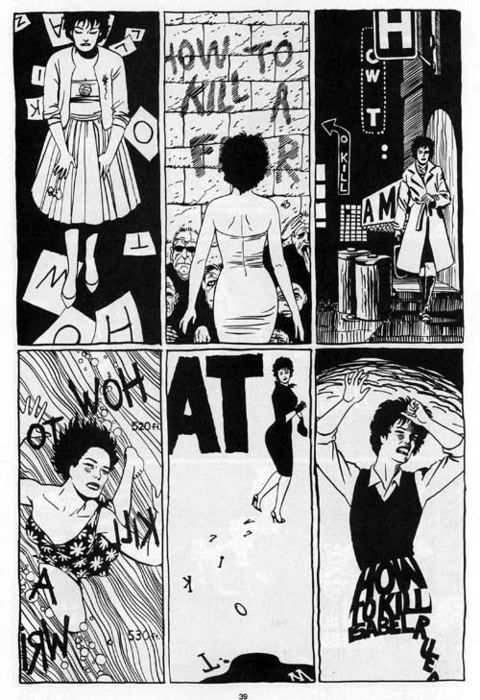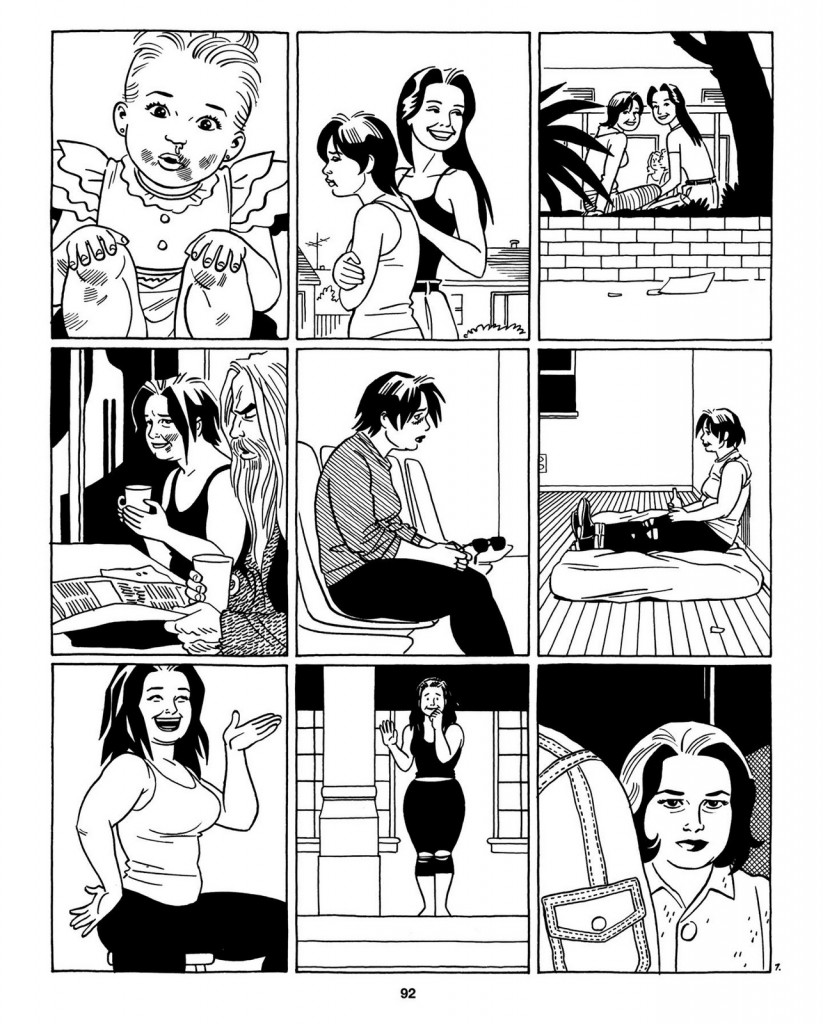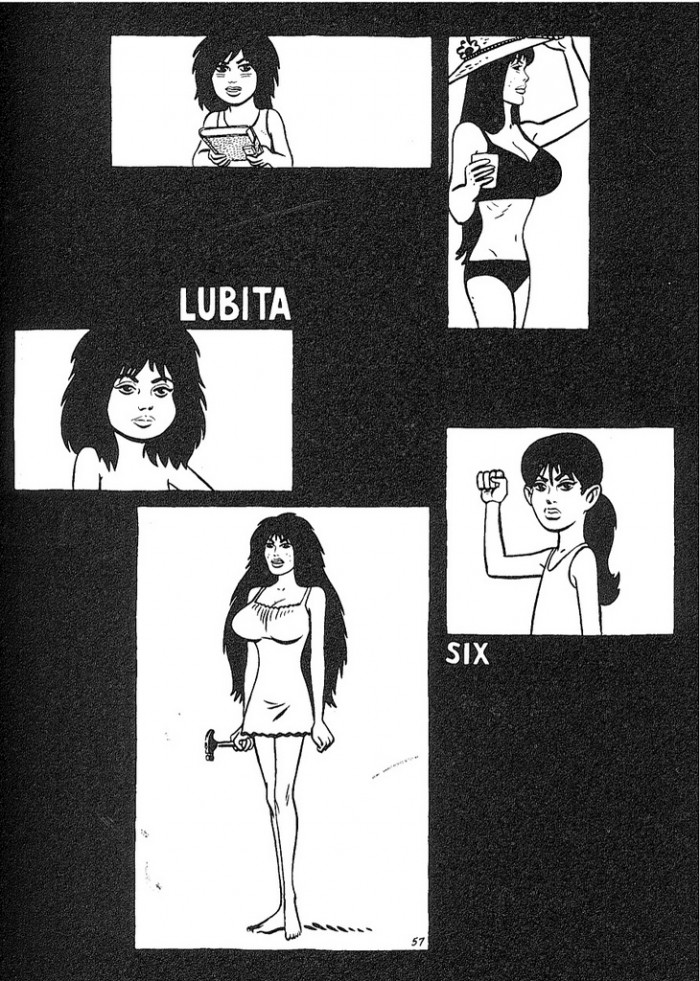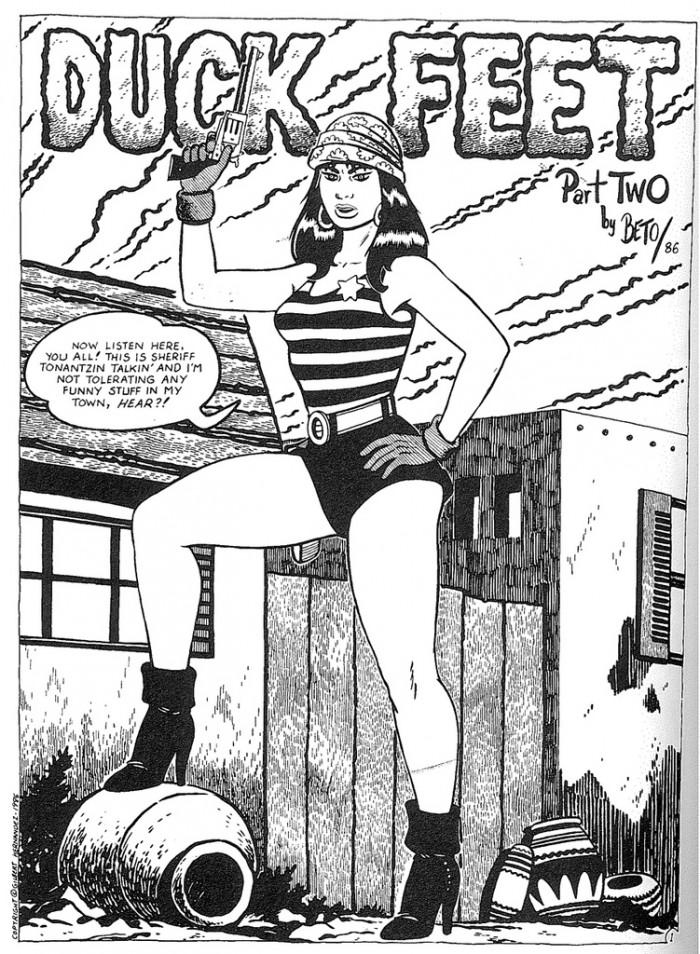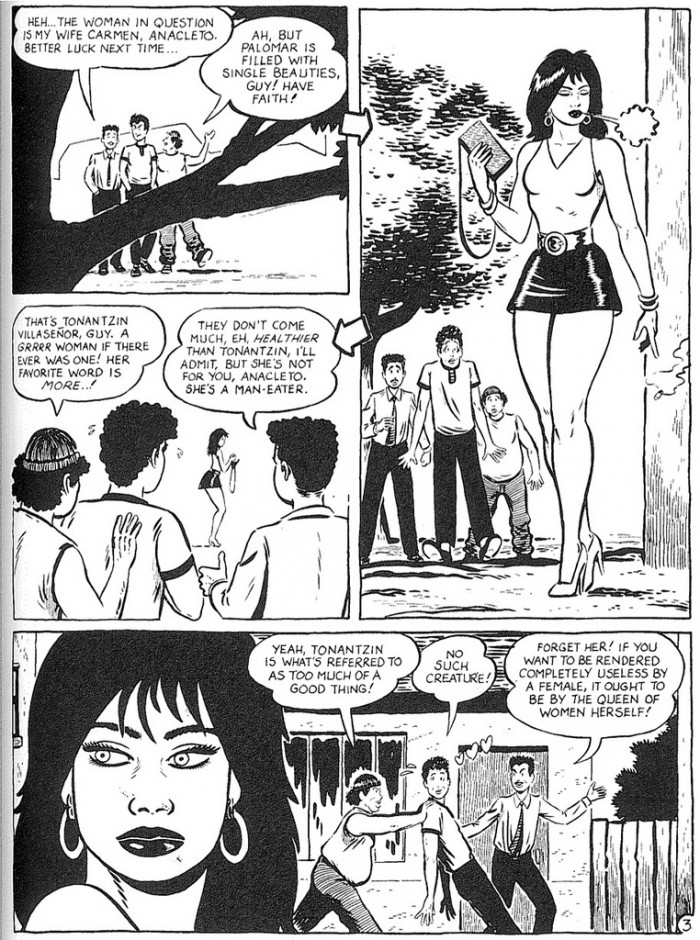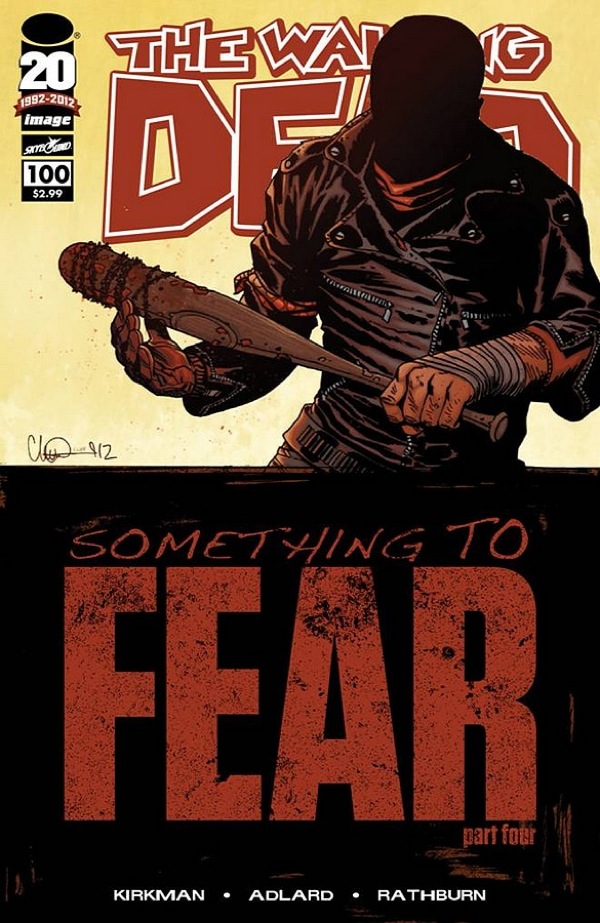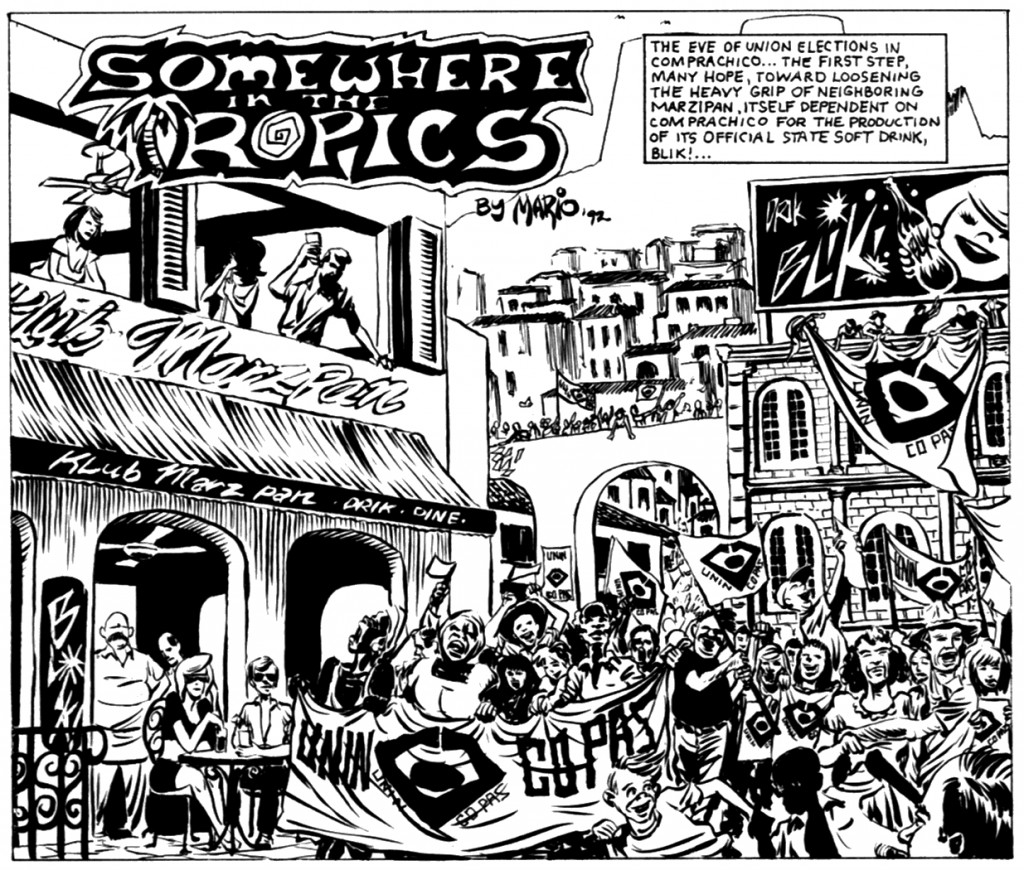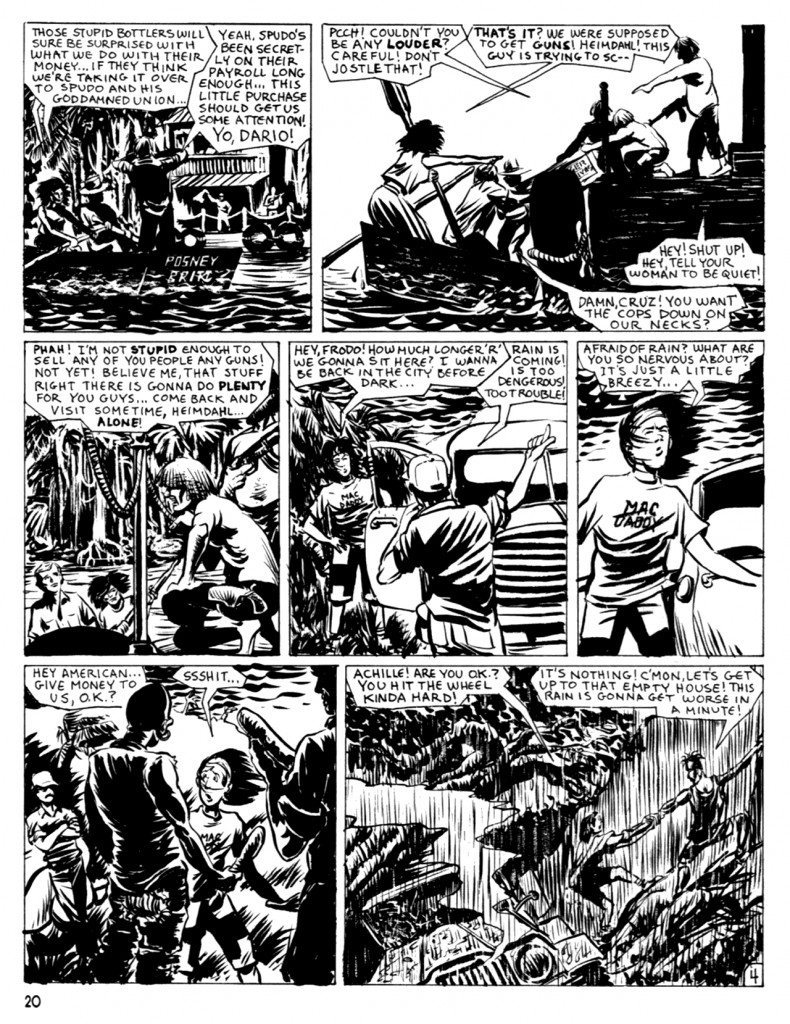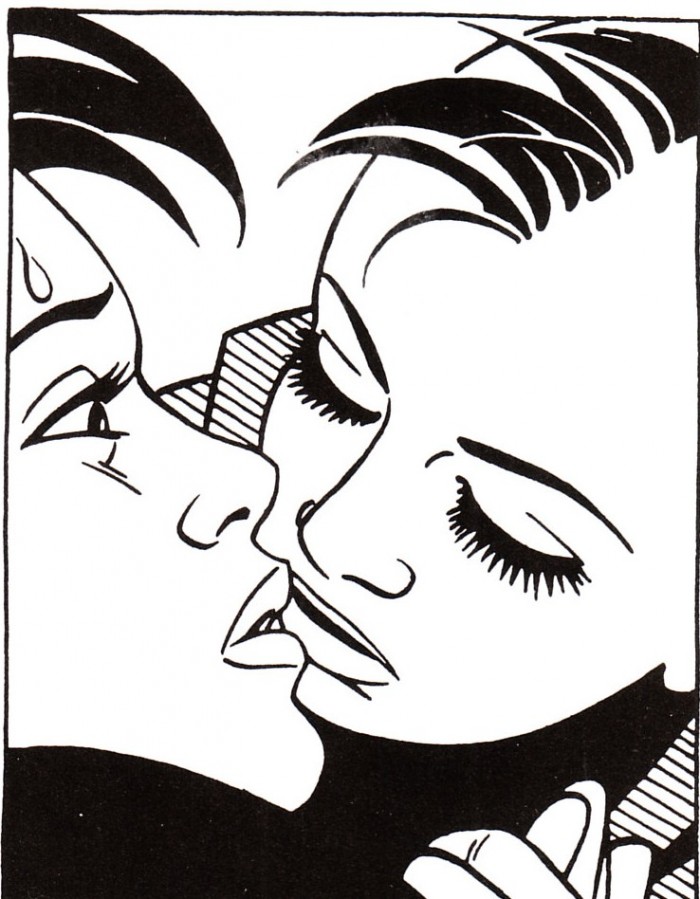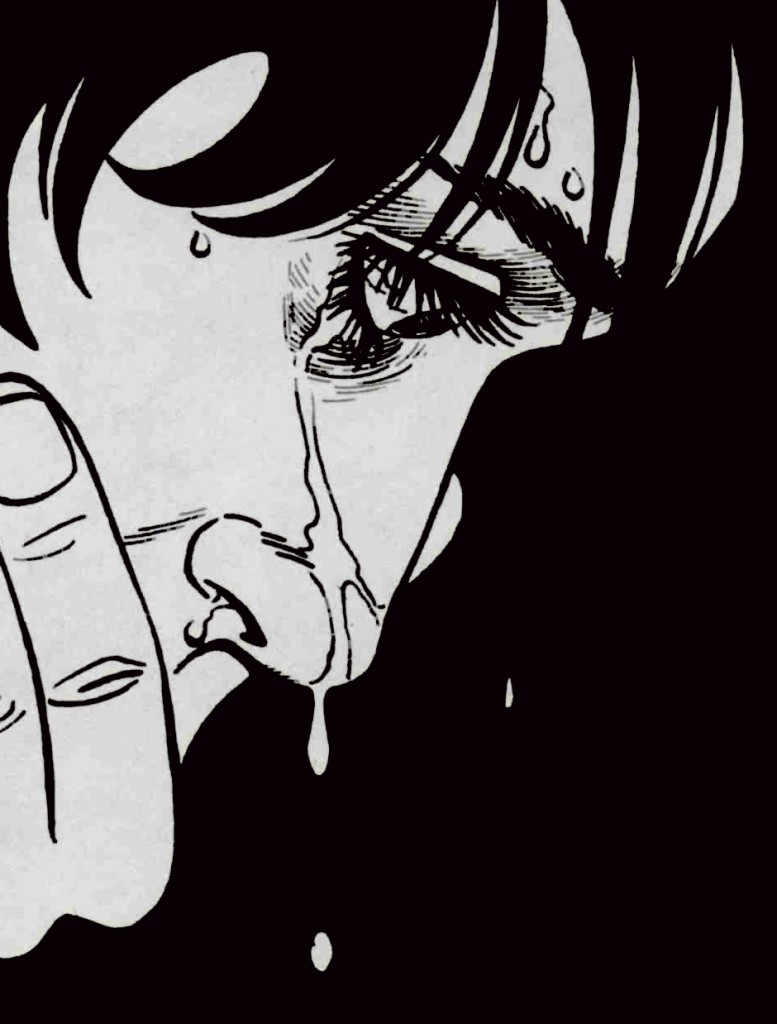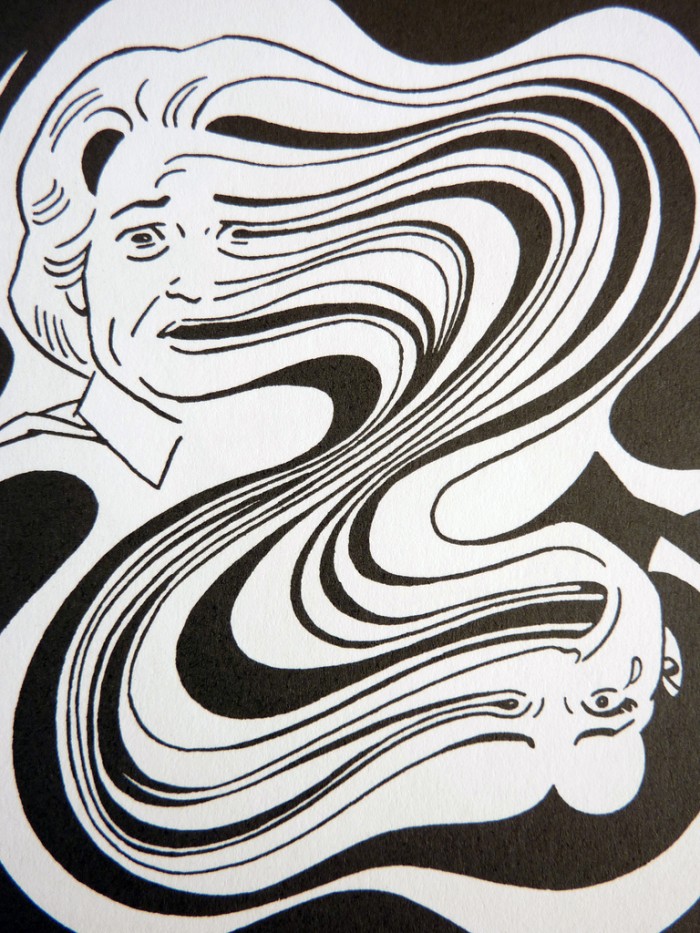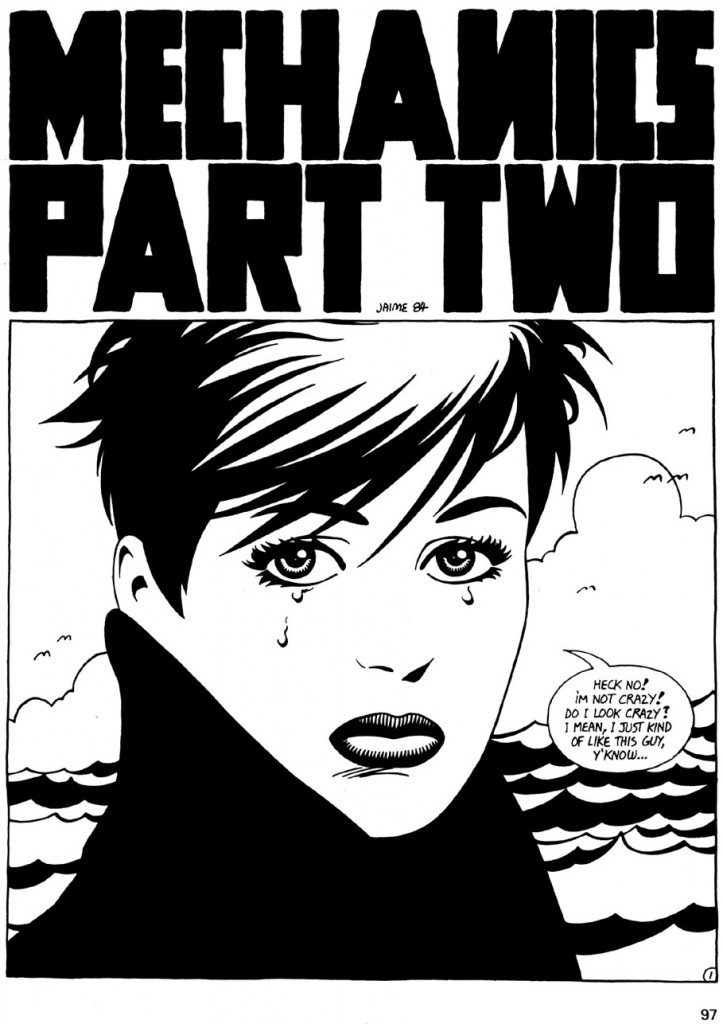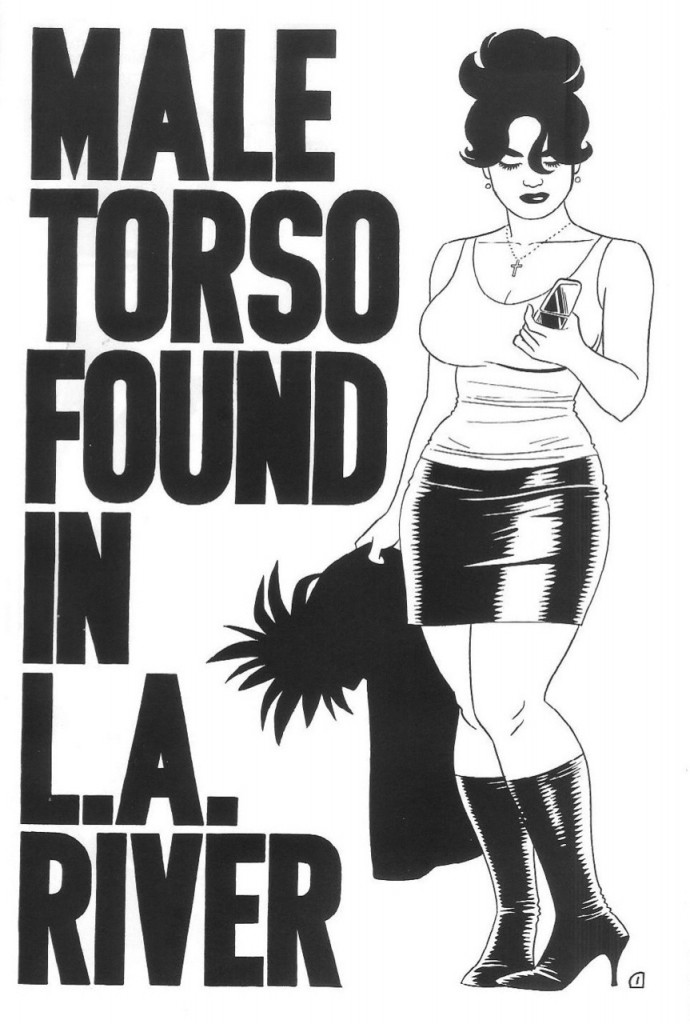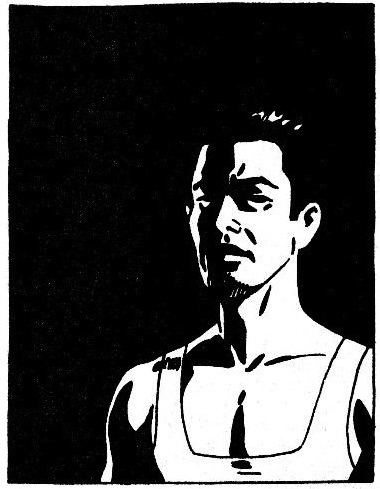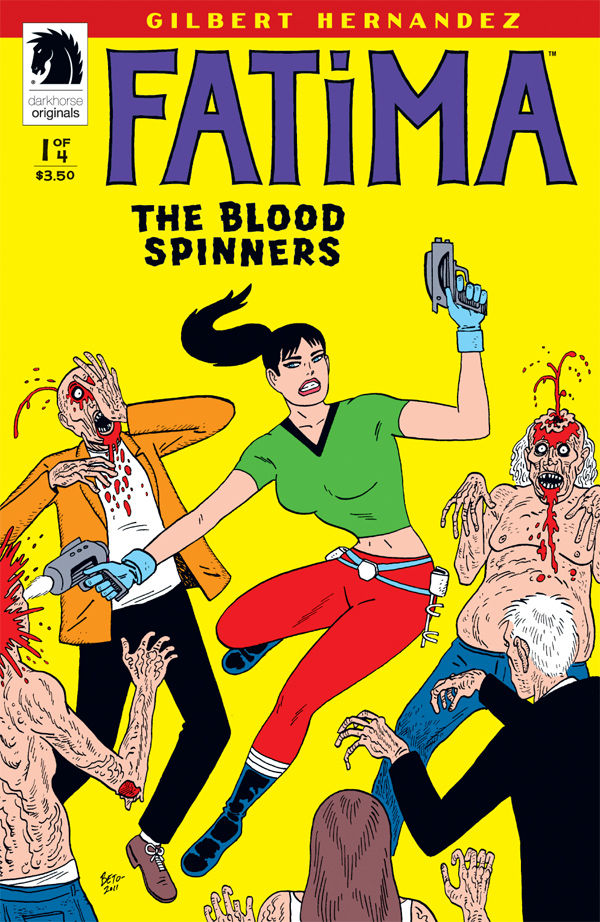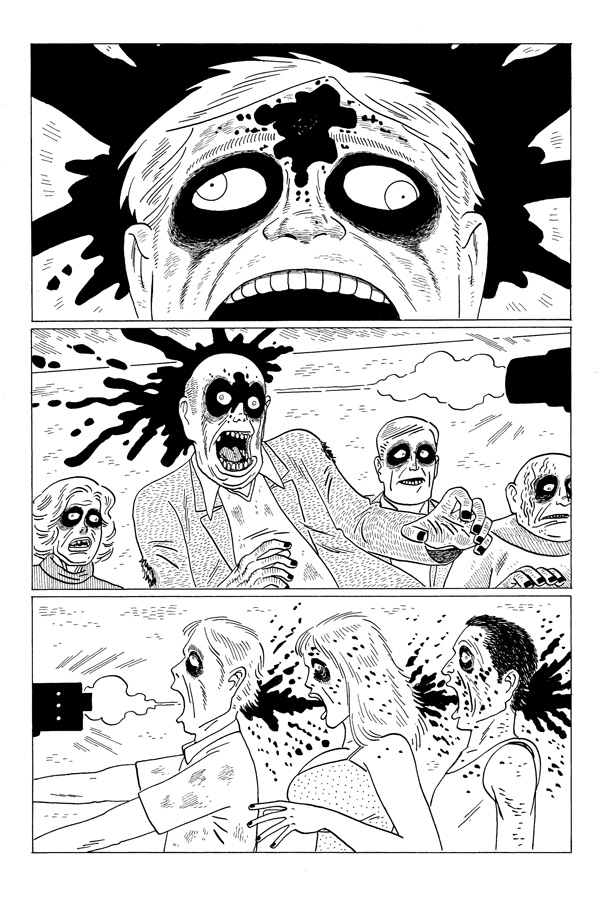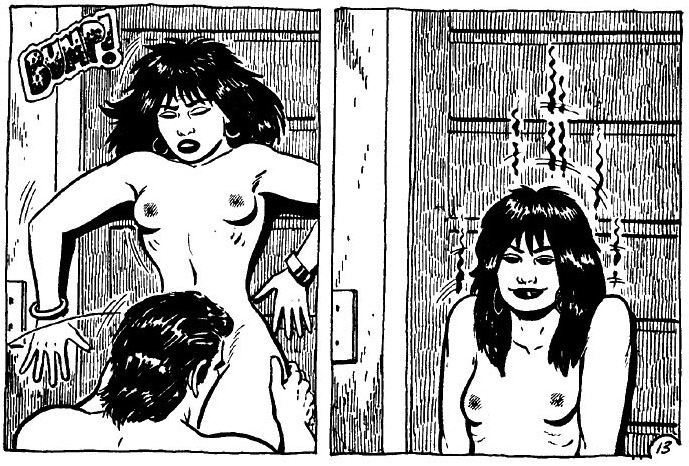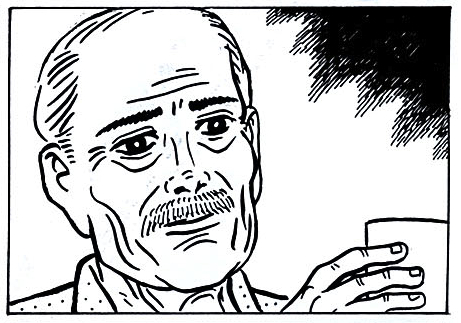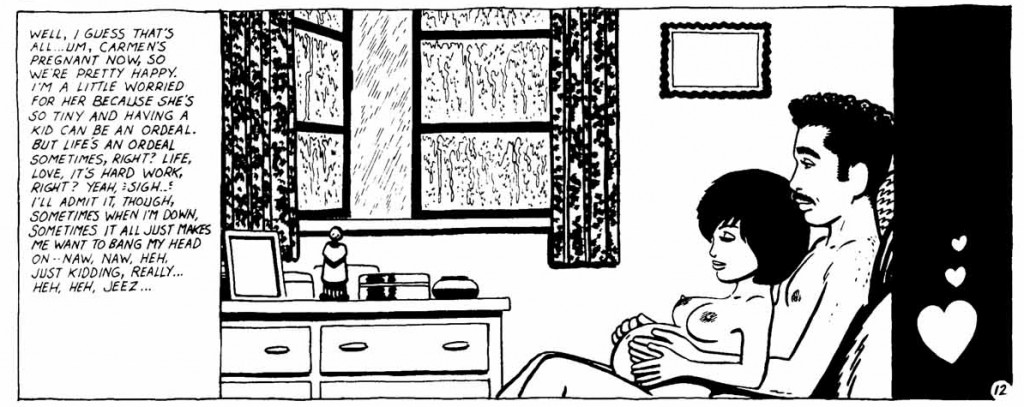Posts Tagged ‘comics reviews’
Comics Time: Ant Comic
March 25, 2013I reviewed Michael DeForge’s masterful webcomic Ant Comic for The Comics Journal.
Please read the comic; it’s gorgeous, funny, troubling, and powerful, and you can read it all on a lovely single scrolling page.
Comics Time: Black Is the Color
March 21, 2013Far, far away
March 15, 2013This week on Vorpalizer I wrote about Sam Alden’s webcomic Haunter and George Lucas’s movie series The Star Wars Trilogy. Spectacle and scale are the main concerns.
Comics Time: Prison Pit Book Four
February 7, 2013Prison Pit Book Four
Johnny Ryan, writer/artist
Fantagraphics, 2012
116 pages
$12.99
Buy it from Fantagraphics
Buy it from Amazon.com
For today’s Comics Time review, please visit The Comics Journal.
Vorpalizer
February 6, 2013I’m going to be writing about science fiction, fantasy, horror etc. with some dayjob coworkers at our new group blog Vorpalizer.com. I got started with posts on Michael DeForge’s Ant Comic and Susan Cooper’s The Dark Is Rising. Come check it out.
Comics Time: My Friend Dahmer
January 3, 2013My Friend Dahmer
Derf Backderf, writer/artist
Abrams ComicArts, March 2012
224 pages
$17.95
Buy it from Amazon.com
In introductions, afterwords, and interviews alike, Derf Backderf makes it abundantly clear that his sympathy for Jeffrey Dahmer, his old high school acquaintance and serial killer of young men and boys, ends when Dahmer’s murders begin. By coincidence, so does the story he tells in this book, pretty much: Dahmer began killing upon graduation from high school, at which point he also dropped out of touch with Backderf and his circle, thus closing Derf’s window on his darkening world.
But while My Friend Dahmer abhors Dahmer’s crimes, it also does him, and his victims, the courtesy of never saying what they are. No body counts; no grim stories of the homophobic cops who returned a nude, wounded underage boy who’d escaped Dahmer’s clutches to his eventual killer before making jokes to their dispatcher about getting de-loused; no gruesome accounts of body-part altars and DIY trepanation attempts. The endnotes in the backmatter deliver the basic facts, but in the comic itself he consigns his old friend’s crimes to the void, perhaps the most empathetic thing he could possibly do with them.
The story Backderf chooses to tell is one of uncontrollable urges. At one point he describes them in the purple terms of mass-market true-crime paperback back-cover blurbs, as otherizingly and alienatingly as you please: “What spawned this perverse sexual hunger? What deep, fetid part of his psyche gurgled up this miscreant desire, so powerfully voracious it immediately devoured him whole?” But immediately before that he makes the direct connection between Dahmer’s necrophilia and his own irresistible adolescent lust for his female classmates, one of whom he draws walking alluringly down the hall in tight jeans, her spherical asscheeks drawing his attention as inexorably as a local jogger commands Dahmer’s far more lethal lust.
The girl’s body points to the great strength of Backderf’s resolutely unstylish art: Everyone’s a collection of lumps and bulges, molded into shape by his thick, blunt ink line. This isn’t the only prominent ass we see drawn this way, as it turns out: Another belongs to Dahmer’s mom, clenched in unflattering high-waisted mom pants as she seizes uncontrollably due to a morass of psychological, neurological, and pharmaceutical problems. Her trembling, sweat-soaked, jut-jawed body locks into bizarre, almost vogue-like positions, her neck craned upward at a 90 degree angle like a modernist portrait. She’s reduced to her body in these moments. “This,” Backderf writes, “is what Jeff came home to.” Dahmer’s mind rapidly reduces all life to mere bodies, bodies over which he can exert control. In fact, it’s his imitation (unbeknownst to his classmates, who think he’s making fun of someone else) of his mother’s symptoms that makes him a legendary character among his classmates.
The implicit connection Backderf draws between all these things is that Dahmer couldn’t help how he felt about dead men any more than Derf could help how he felt about pretty girls’ rear ends or than his mother could help having fits. What they all could control is how they responded to them, or to anything else. That’s where Backderf’s real anger is directed: at the choice of Dahmer’s parents to abandon their son — first emotionally and then quite literally, leaving him to live by himself in their house as they went their separate ways following an acrimonious divorce — and at the apparent choice of their high-school teachers and administrators to ignore the heroic quantities of alcohol Dahmer was consuming during the school day to self-medicate his urges away. The moment his parents left and school let out, even the minor impediment of negligent adults was removed entirely, so the alcohol was no longer enough, and the last few tethers holding Dahmer to sanity snapped. If some adult had cared enough to wrestle those urges to the ground, Backderf argues, Dahmer’s lonely life would still have been a sad one, but the lives of dozens and dozens of other people would have been far less so. The goal of this book is to lead you to the chasm between the potential and the actual and scream into it. Between the idea and the reality, between the motion and the act, falls the Shadow.
Comics Time: Flayed Corpse
December 21, 2012Flayed Corpse
Josh Simmons, writer/artist
Oily Comics, 2012
12 pages
$1
Buy it from Oily
I reviewed Flayed Corpse by Josh Simmons for The Comics Journal. Happy Holidays!
Comics Time: 67 monthly comics
October 23, 2012A couple weeks ago I realized I hadn’t read a single monthly comic book series since August 1. That’s the longest I’ve gone without reading a comic from the industry’s serialized backbone since I started reading comics in earnest again in the spring of 2001. Looking back, there were many reasons why I took this unplanned sabbatical, some of which it shares with my deliberate step back from writing about comics at the same time, but “I don’t enjoy these comics anymore” was not one of them. It’s an odd, transitional period for serialized action-adventure pamphlet comics, the kind people call “mainstream”: Marvel’s longest and in some cases best runs are all about to come to an end as they shuffle writers to new projects en masse, DC’s New 52 relaunch appears to have pushed my old favorite Grant Morrison into winding down his titles as well, and the Image-led renaissance in non-corporate non-shared-universe creator-owned comics may not be equal to its hype but certainly provides ample opportunity to read finely crafted action-adventure comics far removed from the line-wide editorial diktats of the Big Two. There’s an end of an era feeling in the air, and depending on how things shake out there may never again be a time when I’m reading and enjoying as many of these comics as I would have been reading and enjoying during those two and a half missing months.
So over the past two weeks or so, I crammed. Here are my impressions of the 67 comic books I read during that time, written in the order I read them. They’re all books I either have an established track record of liking or new titles I thought sounded interesting, so the result probably isn’t a useful portrait of What’s Not Working in Monthly Comics Today. The stuff I knew wasn’t working, I stayed away from. But I definitely didn’t end up liking everything I thought I’d like, and ended up liking some things more than I expected, so there are a few surprises in there.
Before I start, let me note for the record that this is absolutely the way to read these things, if you can help it: binge on them in big chunks. The serialized monthly comic is an almost uniquely inefficient and cost-ineffective art-delivery mechanism, so anything you can do to stack the deck in the favor of a satisfying single-sitting reading experience helps.
Avengers vs. X-Men #10-12, AvX VS #5-6: I liked this thing. It was certainly the best non-Final Crisis major line-wide event comic since Infinite Crisis kicked that era off. Wrapped up a lot of narrative and thematic threads from throughout the nu-Marvel era in fairly organic and enjoyable fashion. The action was engaging and intelligible, aside from a couple of weak spots (Bendis can’t write action and Coipel can’t draw it). The all-fight spinoff comic was a terrific idea–pure fluff, and a million times better than seeing the umpty-umpth splash-page melee with people shooting lasers in all direction that constitutes way too much superhero-comic action these days. I even liked the overall tonal progress of the series, how it went from being very much in line with Bendis’s usual seen-it-before military-superhero stuff to an X-Men mutant dystopia to a war of the gods, with the heroes flying and teleporting around from mystical cities to floating island prisons to Limbo to the moon, conducting their fights literally above the heads of the hoi polloi. Cyclops killing Professor X is a great story beat and I actually think this editorial/creative regime will make it stick for some time. And man, was it an orange book by the end. When I think of this series I’ll think of fire in the sky, which sounds really overdramatic and cheesy now that I’m typing it out, but it’s really not a bad look for an event comic to have a prevailing, lingering mental palette like that, one that overlaps with the overall tone and theme and story. If you’re predisposed to shit on this sort of thing nothing here will make you change your mind, but I’m almost always up for a good time at the movies and that’s what this provided me.
Action Comics #13 & #0: The bloom’s off the Morrison rose and he has no one but himself to blame, between a take on the Superman Year One concept and character that has never quite clicked, a relationship with the artists on this title that also hasn’t clicked, and a series of lame dodges and venal fuck-you-I-got-mine responses to creator’s rights issues either brought up by interviews or offered without prompting in his book Supergods. That said, these two issues contained my favorite aspects of Action Comics so far: the relatively convincing relationships between Clark Kent, Lois Lane, and Jimmy Olsen, here portrayed as young journalists getting a start in the big city by attempting to make uncompromising work, characters of a sort you basically never see; and done-in-one All Star Superman-style run-ins with Kryptonian villains, in this case the first criminal sentenced to the Phantom Zone. The art by Travel Foreman was memorably burned-looking, the take on the Phantom Zone creepy and unpleasant, and I’m a mark for Krypto stuff. It’s hard to take Morrison stories about the unbeatable power of good over evil when he abdicates any and all responsibility to behave ethically toward his peers and forebears IRL, but sometimes artists can lead you to the promised land but not enter themselves and that’s okay. Atheists write lovely hymns sometimes.
The Walking Dead #102, Michonne Special, and #103: One of the nice things about this series is that it can set up a new status quo, like Rick convincing his community of survivors to surrender to a more powerful and dangerous rival community, and you know Kirkman will have the follow-through to stick with this new status quo for, potentially, a year or more, and that when time’s up it won’t just get restored to the status quo ante. You can put up with a lot for that sense that “hey, this matters.” Over in the Michonne Special, which seamlessly edits an origin story written and drawn for Playboy (!) into a reprint of Michonne’s first appearance in the series, it’s striking how much Charlie Adlard’s art has changed from what looks now like an attempt to ape previous artist Tony Moore’s expressive, definitively delineated oblong faces into his own loose moody gray thing.
Uncanny Avengers #1: This is 99% set-up for future storylines, and said set-up is 99% angry superheroes telling each other how disappointed in each other they are, which I’d be happy never to read again. Rick Remender is an entertaining superhero team writer but much more so on certain titles than others, and this is an inauspicious start.
Powers #11: I was all set to say “so much time goes by between issues of Powers that you forget why you’re reading it anymore” but this issue was involving and lovely, with big breathless layouts in the big smackdown of Walker and Triphammer vs. some giant green god-thing and a moment that tied together years of storylines I’m surprised I remember. I see they’re going to relaunch the thing yet again as Powers Bureau, and we’ve seen this movie before: three or four on-time issues, then waiting five months each for the final two installments of the initial arc, then reading that Bendis and Oeming are back with a vengeance for the all-new story arc. I don’t look forward to the waiting or the fingers-crossed promises, but I do look forward to the reading. I wish Bendis would drop the assignments and the TV pilot that prevent him from putting out more of this, at a rate sufficient to help us forget we’ve seen a lot of these story beats before.
Invincible Iron Man #523-526: Not everything works in Matt Fraction and Salvador Larroca’s lengthy Iron Man run—the supporting cast at Tony Stark’s company resilient never distinguished themselves beyond “the people Tony and Pepper Potts banter with at meetings,” the stunt “casting” of, say, Nicole Kidman as Pepper lessened as time went on but was still distracting, and the less said about Tommy Lee Jones The Cussing Dwarf the better. But most of it worked very well indeed. Larroca’s art and Frank D’Armata’s colors look every bit as shiny and candy-coated and slick and future-ish as they ought to; nothing else in superhero comics looked like it in turn, that much I can say. Fraction gets Tony Stark as well as anyone this side of Robert Downey Jr., his intelligence and ego the only things that can get him into the scrapes he gets into AND get him out of them again — a great fit for Fraction as a personality based on what I can gather. Fraction’s Stark is just a pleasant character to spend time with. Plus there’s simply a lot to be said for guys in armor flying around punching each other. Even the Mandarin’s off-brand version of supervillain megalomania is compelling. This is one of the most consistently enjoyable superhero runs of the past decade, and I’ll be glad to see it end in a month or two only in the sense that then I can have a complete run of it.
Winter Soldier #9-11: Speaking of lengthy runs that are about to wrap up, Ed Brubaker’s tenure on Captain America and its assorted spinoffs is nearing the finish line, too. Just a wonderful match of writer to character, even if everything after Steve Rogers’s return from the dead has felt a bit like gilding the lily. The artists on the main title have strayed from the visual template established by Steve Epting and Mike Perkins back in the day, but here, Butch Guice is working right in that “naturalist depictions of superhero antics” sweet spot that made Bru-Cap the perfect blend of black ops, superspy, and Star-Spangled Avenger. Most of the time, at least — other times it looks like he’s just tracing photos to save time. It’s weird, how dramatically it shifts. Nice colors from Bettie Breitweiser, though, working in the teal-and-orange palette of Jimmy Corrigan’s cover and simultaneously muted and garish at the same time. Kind of glo-fi on occasion. Finally, Black Widow fights Bucky while wearing a ballerina costume.
Invincible #94-95: Here Kirkman gives us a sort of My First Sony version of the old sci-fi trope where centuries pass for characters stranded on an alien world while they and the Earth they come from barely age at all. The disconnect between the immensity of that experience and demeanor of the characters involved is so massive it’s all but played for laughs, but given the fact that these are two very much supporting players and yet the book is still spending issue after issue on this story, it’s still an entertaining example of Kirkman’s willingness to both go big and go offroad. Series co-creator Cory Walker draws the alien-world stuff; I think his design for the grown-up Amanda Monster Girl is hella cute. I’m always glad to have read Invincible when I put it down because I never know where it’s headed when I pick it up–I certainly didn’t see this storyline coming. Who could’ve?
B.P.R.D. Hell on Earth: Return of the Master #1-2: Tyler Crook had the thankless task of following the great Guy Davis on this title (literally thankless in the sense that Dark Horse barely said boo about Davis’s departure–I still scratch my head about that) and preceding the tour de force monster on monster combat story arc illustrated by James Harren. So you can hear the collective kvetching when he’s on duty. But his work is just fine — not as creepy as it should be, perhaps, but very expressive, which was always the other big tool in Davis’s arsenal. I’d rather have good acting from the characters than super-scary visuals, frankly — it’s made the relationship between the secretly evil Russian zombie guy and his imprisoned immortal-little-girl predecessor at the top of Russia’s BPRD equivalent a lot of fun to watch, for example. Anyway I feel like the best thing for the Hellboy/BPRD saga would be for it to end in the middle-term future — it’s been a marvelous, unpredictable, evocative ongoing series but it needs a true ragna rok to stick. Hopefully we’re headed there.
Lobster Johnson: The Prayer of Neferu: You could go either way with these Hellboyverse spinoffs and say that their tangential relationship to the main story helps them — they’re looser and freer and less burdened by a sense of building to a climax that never comes — or hurts them –it’s not the character-based Lovecraftian good stuff so who cares. I guess I’m in the former camp for this one. Wilfredo Torres’s faces are a bit too obviously photoreffed but ooftah, that line of his! Loose, thick, luminous, lively. Shades of Dave Stevens, maybe. Meanwhile, Lobster Johnson crashes a party full of gangsters and reincarnated Egyptian occultists and sticks around until he’s managed to kill all of them, then leaves. Ruthlessly efficient.
Uncanny X-Force #29-32: Four issues in two months. This doesn’t bother me like it’s bothered a lot of people, since I haven’t seen any dimunition in the quality of the stories Rick Remender’s telling, and the art, while inconsistent, is always competent and almost always colored by Dean White, one of the best in the biz and the book’s aesthetic lynchpin. Granted, though, he’s less in evidence by the end of this little run, and that’s a loss. Anyway, no, generally I’m fine with lots of Uncanny X-Force. This run made me realize how much Remender is willing to stack the deck against his own theme. The idea behind Uncanny X-Force is that violence poisons the souls of those who commit it, even for the right reasons — and not in the usual, hardass, “down these mean streets a man must go”/”you want me on that wall” way that books starring the Punisher and Wolverine usually approach this stuff. No, all the characters here, their lives are legitimately worse than they were before they signed up, and they know they have only themselves to blame. The interesting thing there, though, is that Remender pursues this theme in the face of antagonists who are just out-and-out monstrous psychopathic villains with “does what it says on the tin” names like Apocalypse, Dark Angel, and the Brotherhood of Evil Mutants. (He’s done the same thing in Secret Avengers, too, resurrecting the Masters of Evil.) X-Force’s opponents either have evil in their name or preside over alternate realities where the consequences of not stopping them are visible everywhere. Yet the message, that engaging these thoroughly awful murderers by murdering them in turn is wrong and destructive, remains. It’s exciting to see someone willing to make extra work for themselves to make their point stick.
Batman Incorporated #3 & #0: Morrison’s still got the fire here, I’ll say that much. Obviously having Chris Burnham and Frazer Irving in your corner goes a long way toward creating that impression — Burnham’s taken Frank Quitely’s pointillist approach to action and made it his own, and Irving can just do so much with so little, from boiling chase sequences down to figures made from little shapes of color to drawing gorgeous Jonny Negron-style hip ladies getting down. But the story itself remains engaging, giving the impression that you’re about five feet away from being able to see the whole picture, but it keeps advancing right along with you to keep the answer to the mystery tantalizingly out of reach. That’s how Morrison’s been handling his conspiracy-based Bat-run for years and years now, and it remains an electric read, even if his concept of a corporation dedicated solely to do-gooding now reads like pure projection. Or perhaps it’s not “even if” but “because,” I don’t know.
Happy #1: We all get it: Morrison’s doing a parody of Mark Millar and Garth Ennis, with Ennis collaborator Darick Robertson riding shotgun. That’s nice, I guess, but as far as this first issue is concerned, it’s all set-up and no subversion. It simply reads like a undistinguished example of what one assumes he’ll be sending up in a more ambitious fashion by series’ end. It’ll be a bit of a slog getting there with these undistinguishable foul-mouthed hardasses vomiting f-bombs at each other. Still, I like Robertson’s art well enough — maybe it’s just reading this and Batman Incorporated back-to-back that did it, but now I can see his influence on Burnham, and that influence is reflected back in a way that makes me appreciate him more.
Secret Avengers #30-32: Compared to writer Rick Remender’s similarly structured Uncanny X-Force, there’s just…not a lot going on here. The closest it gets to a theme is the use of Marvel’s various android characters for a look at what makes us human, an issue I’ve never felt compelled to grapple with, seeing as how the question is basically answered every second of every day you get up in the morning. Nominally this storyline is the payoff to a grand mystical conspiracy introduced by Ed Brubaker in the inaugural arcs of the series before he realized he doesn’t like writing team books and bailed, but the payoff is a dud — literally, pretty much, as nothing happens when the archvillain pulls the trigger on the superweapon he’s spent the entire series to date preparing. The figurework by Matteo Scalera is scratchy and elastic in a way that softens the impact of the black-ops and hand-to-hand combat that drives the story. It’s inoffensive, and occasionally fun, but extremely slight — exactly what I’d worried it would be after that initial preview issue back when, and impossible to overlook now that it’s not being papered over by the lovely cosmic artwork of Renato Guedes and Bettie Breitweiser from the Avengers vs. X-Men tie-in arc.
Lobster Johnson: Caput Mortuum: And this one is super-duper slight, yet its mere presence in the Mignolaverse, the implacability of its lead “character” (Lobster Johnson is something of a deliberate cipher), and some exciting action stagecraft played off of Tonci Zonjic and Dave Stewart’s solid and efficient artwork make it feel like a much more worthwhile affair. It’s weird to read a Hellboy/BPRD-related book without a single hint of the supernatural — this is just a vigilante against Nazis with an advanced chemical weapon — and that may speak to the overextension of the concept generally, but not enough to complain about the particulars.
Captain America #16-18: Well, this is a bummer. After a near-decade run that was arguably the best in the character’s history, Ed Brubaker hits the eject switch from Marvel in favor of TV projects and creator-owned stuff, and in the confusion a co-writer is roped in to handle his final full arc on the title, which seems to mean scripting off of Bru’s plot. So a long-running storyline about Cap’s primary antagonist for the past year or so is basically taken out of Brubaker’s hands, with even his trademark, claustrophobic narrative captions removed, and the result is just unspectacular superhero boilerplate. Doesn’t help that artist Scott Eaton isn’t elevating the material, although the menagerie of three inkers and two colorists he’s saddled with in issue #16 don’t exactly give the impression that this is the thought-through product of a singular vision either. I believe Brubaker’s getting his very own farewell issue, at least, but this is a pretty depressing example of Marvel’s need to move product trumping what had been one of its creative highlights for literally years. If you’re keeping track, it’s much worse a sin than the cast of thousands necessary to make Uncanny X-Force a biweekly title, but way better than Brian Bendis being forced to unceremoniously kill off Ultimate Spider-Man after well over a hundred issues and replace him with an interesting character hamstrung by a gross tribute to union-busting school-“reform” propaganda film Waiting for Superman because Mark Millar tossed out the phrase “Death of Spider-Man” on his way out the door of a creative summit.
Prophet #28-29: This series has been just fantastic, a most welcome addition to the few, the proud, the “who knows what the hell’s going to happen when you open any given issue of this book?” monthly series. Deadly serious yet never humorless — a trick known to its pulp antecedents (it’s very much Space Conan) but hard to pull off in the present day. The scale of this “literature of ideas” take on SF is just phenomenal — all the concepts are just so big! It’s the universe as a massive, rotting body, with each individual alien or warrior or creature or robot the tiniest of molecules in the tiniest of cells in some small organ or digit somewhere, locked into a life-and-death drama with no sense of its own inconsequentiality relative to the grand scheme of things. It’s actually rather breathtaking. The rhetoric surrounding the comics of Brandon Graham, who here is “just” the writer where elsewhere he does the lot, has been messianic enough to make the most ardent Grant Morrison fan blush (I know whereof I speak there), and I personally bristle at his boilerplate Chris Ware disses, but there’s no sign of any of that affecting his work for the worse here. Even his use of puns, perhaps his greatest vice elsewhere, is judicious and illuminating (“mind field” instead of “mine field” is the main one here, and it’s an evocative and informative turn of phrase). Graham has a stable of talented off-model sci-fi artists to work with, though the standout here is the stunning gray-white color work of Joseph Bergin III and Charo Solis in issue #29. Realizing the connecting thread to the series’ done-in-one format was one of my favorite eureka moments in the past couple years of comics, and it continues to be one of the book’s great delights. Simply a pleasure from start to finish.
Fantastic Four #609-611 and FF #21-22: Writer Jonathan Hickman wraps up his long-running, interlocking dual Fantastic Four series with a series of one-shots and two-parters dedicated to individual subplots and supporting characters. That’s a fine note for the series to end on, as I’ve always been much less impressed by its long-game clockwork narrative structure — for all the breathlessness of Hickman’s writing this has always felt like an academic exercise to me, tied neither to a Morrisonian sense of creepy mystery nor a Moore-style autopsy of humanity’s inevitably failed attempts to remake the world in its own image — than by the way it simply places likeable characters with fun powers in close proximity with big cosmic superhero sci-fi ideas. It’s tough to go wrong with that, or at least it should be. I like Hickman FF less than Fraction Iron Man or Brubaker Cap, but I still like it, and as with those other series I’ll be glad to have The Complete Jonathan Hickman Fantastic Four &c on my bookshelf.
Green Lantern #12, Annual #1, #0, and #13: I’ve always thought Geoff Johns’s Green Lantern run works because a) he cracked open the concept and found a whole new world of possibilities inside, and b) those possibilities stem from the childlike simplicity of “what if there were other colored power rings?” which is pure inner-eight-year-old gold. But this recent stretch of GL books (and good luck figuring out what to read in what order, all those new readers attracted to comics for the first time by the New 52, we know you’re out there) makes me realize something else that’s going on here: Green Lantern is a daytime soap opera, but instead of rival families, there are rival lantern corps. There’s that same neverending roundelay of emotionally pitched, for-all-the-marbles confrontations that, miraculously, just seem to break down and reconstitute themselves with a different alignment of the players a few months later down the line. Right now, Hal Jordan and Sinestro are allies against the Guardians, who are using Black Hand in a plot against all the lanterns. A few months ago Hal and Sinestro and the Guardians were united against Black Hand. Before that Hal and the Guardians were united against Sinestro. And so on and so on. I like these characters and concepts, and I like the artists who draw them (particularly Doug Mahnke, who gets a nice glory shot of the Justice League on the final page of #13), so I’m up for watching the kaleidoscope shuffle and realign. As a side note, the last couple issues see the introduction of a new Arab-American, Muslim Green Lantern, who is recruited by Hal and Sinestro’s shared power ring while he’s in the middle of being wrongfully accused of, and tortured for, terrorism by the American government. That’s a super-duper progressive superhero origin, and one that’s likely to be a lot more timeless than Greg Rucka’s Batwoman character becoming a vigilante after getting bounced out of the military under Don’t Ask Don’t Tell. Depending on whether you choose to emphasize the progress of gay rights or the rise of open Islamophobia, this is a real half-full/half-empty situation.
Marvel Now Point One: This is an anthology one-shot featuring various prologue short stories by various creative teams of various upcoming titles. I’ve read around 40, 50 monthly comics in under a week at this point in this little project, and I could make heads or tails out of a grand total of one of these stories. (The Fraction/Allred/Ant-Man one, a teaser for a future Fraction/Allred FF book I won’t be reading because Allred did a variant cover for Before Watchmen, which is the same reason I’ve dropped Mark Waid’s Daredevil now that Before Watchmen cover artist Chris Samnee is the regular artist. Both of these men can get out of Before Watchmen Scab Limbo by donating their proceeds to charity, Paul Pope style!)
B.P.R.D.: 1948 #1: This is the first BPRD comic to spook me in a while, mainly because I find the thunderbird legend deeply unnerving. The idea that even as well-trod a territory as America is big enough to house a relict population of birds the size of a city bus…I don’t know, it’s like staring into the ocean or the night sky in some way. The bird in this BPRD comic isn’t a bird at all, mind you, it’s a cthulhoid monstrosity of the Hellboy/BPRD kind, but it’s playing with thunderbird imagery and it’s creepy. I like it.
Godzilla #4-5 and Godzilla: The Half-Century War #1-3: If you’d told me this time last year that I’d soon be reading not one but two beautiful, rollicking comic book series starring Godzilla and drawn by artists on the alternative-leaning side of indie comics, I never would have believed you, but lo, it has come to pass. I never talk about this for some reason, not even relative to stuff like He-Man or G.I. Joe, but I was a huge, huge Godzilla fan as a little kid, with the stack of VHS tapes featuring three movies taped off Channel 11’s Saturday matinees per tape to prove it. These comics do what those movies did: Create reasonably engaging human characters to provide a worm’s eye view of these giant, magnificently designed and imagined forces of nature as they wreak havoc and attack each other. The main title, written by Duane Swierczynski, is sort of the action-comedy/tween-boy animated-series version of the concept, starring a not-at-all-veiled Jason Statham figure as he and his team fly from place to place, taking down giant monsters for large sums of cash. It features the art of Simon Gane, which looks like it was assembled by tracing the wrinkles on crumpled-up aluminum foil, and I mean that in the best way. The monsters look solid, and they pop off the rubble and explosions. Even more impressive is the James Stokoe written/illustrated Half-Century War, which reads like what it is: An already talented and established cartoonist given the reins of something he loved as a kid and given carte blanche to do his own thing with it. This one’s slightly more serious in tone, in the way that monthly action-adventure comics can be “serious,” but it’s primarily a fun-for-fans Ultimate Godzilla, or maybe Marvels Meets Godzilla, that plays with the timeline established by the Toho movies in a sort of real-time way. There are a couple of spreads — the debut of Godzilla’s trademark sound effect and a giant-monster battle royale — that made my jaw literally drop.
Batwoman #12, #0, #13: An unnecessarily beautiful series, co-written and illustrated by J.H. Williams III with color by the amazing Dave Stewart. I mean, this thing…Batwoman has an enormously overcomplicated history in her few short years thanks to co-creator and original writer Greg Rucka’s fondness for some truly dopey ideas, some of which (the half-animal guys that are the rare thing Williams is bad at drawing) linger to this day, but holy god is it a thing of goth glamour and splendor. The reds in the zero issue are worth buying the damn book for. Twelve and 13 are done almost exclusively in two-page spreads, because why not? There’s a spread where Batwoman and Wonder Woman burst out of the goddess of night’s lair by lighting a match that made me say “Jesus!” out loud, it was so stunning. I’m basically sticking with this book on the off chance my daughter turns out to be a Hot Topic shopper in her teens, because this is really remarkable for that demographic, and purely in visual terms for me as well. They really ought to do whatever it takes to prevent anyone but Williams from drawing it, though. (PS: Regarding something I mentioned earlier, I notice they’ve now begun glossing over the fact that she was drummed out of the military by Don’t Ask Don’t Tell, instead simply saying she was kicked out of West Point.)
Glory #29: Joe Keatinge and Ross Campbell’s contribution to the same Rob Liefeld reboot line that spawned Prophet is goofily beautiful — there’s a panel of the main human character Riley smiling as her hair’s black tendrils blow in the chilly wind that I sat and looked at for a solid minute — and the character designs reveal Campbell to be just as proficient with genre body types as he is with the skinny/chubby/everything-in-between goths in his moody slice-of-lifer Wet Moon. This one actually has a couple of post-coital scenes, which means you get to see his hulkingly muscular version of the title character, who used to be just kind of a Wonder Woman knockoff from what I understand, in all her glory, and it’s a hilariously transgressive image. It’s tough to say where this series is headed because there’s always this disconnect between the calm demeanor of the characters and the inevitable slaughter they’re constantly talking about being headed toward, but it’s a really attractive book in the meantime.
Fatale #7-8: This is the first disappointing Brubaker/Phillips collaboration I’ve read. The combination of supernatural horror and noir just doesn’t work: the past-tense neurotic noir narration smothers any potential to present a super-rational shock in the moment, Phillips isn’t really a natural when it comes to framing horrific imagery, and Brubaker’s giving him basically nothing to work with beyond “spooky guys who sometimes have Cthulhu heads.”
Mars Attacks #3-4: Good clean fun. John Layman and John McCrea take the BEMs from the gruesome old Topps trading card series and let them run amok among various action-movie and alien-invasion cliches. This feels like someone’s action-pastiche comic you picked up at BCGF, only it looks like a book that runs in the front of Previews. That’s a fun feeling! These issues featured giant praying mantises eviscerating a college class, and that made me laugh. Very much in the vein of the Godzilla series also published by IDW. I could stand more books like this, sure. Cheap pulp kicks.
Hawkeye #2-3: I hate to use the term Mary Sue, but suddenly Hawkeye’s a down dude who lives in Brooklyn where he attends rooftop parties with his neighbors, he loves 1970 Dodge Challengers, and he’s as irresistible to women as billionaire playboy Tony Stark and famous lawyer Matt Murdock, so what else do you call it. How any of this squares with the basics of the character — why he suddenly lives in Brooklyn instead of wherever it is that the Avengers live, why he’s a super-cool dude instead of the ex-circus ex-con archer guy…I dunno, it feels like Matt Fraction poured a bunch of unrelated ideas into a Hawkeye-shaped vessel because that’s what was available. I’m not saying there’s some One True Hawkeye out there, I’m saying I don’t think Hawkeye, One True or otherwise, is anything but an extraordinarily flimsy frame on which to hang surface-cool writing like this. At least we’re past the Russian guy who said “bro” all the time from the first issue, Fraction’s worst writing since the cussing dwarf from Iron Man, but these issues also set up the distasteful idea that Hawkeye and the girl who took over for him in the Young Avengers want to fuck but think it’s a bad idea, so it’s hardly a step in the right direction.
Fatima: The Blood Spinners #3-4: Gilbert Hernandez’s heretofore relatively lighthearted zombies-getting-shot-in-the-head epic takes a sharp left turn into Sexual Unpleasantnessville, with a pair of mutant-slug-rape-pregnancy scenes that even in this Prison Pit era have the power to shock and horrify. Yet the series maintains its just-another-day-at-the-office tone, from its flat-affect heroine Fatima on down. The matter-of-factness with which Beto presents violence and depravity in this and pretty much all of his postmillennial comics is as harrowing a vision of the world as any cartoonist has ever had, though I can certainly see why lodging such nihilism in an action-adventure romp starring a beautiful lady in super-cute short shorts sits ill with some readers. Gilbert doesn’t make it easy on anyone.
Comics Time: RL Book 1 by Tom Hart
October 11, 2012“[C]omics as a medium could ideally be the most visually honest and consciousness-plumbing medium out there, even more than film.”—Chris Ware
Comics Time: In Situ
August 14, 2012In Situ
Sophie Yanow, writer/artist
Colosse/Export, 2011
40 pages
$12
Buy it from Colosse
For today’s Comics Time review, please visit The Comics Journal.
The Dark Knight Reads: 15 Essential Batman Graphic Novels
August 2, 2012I wrote up a list of 15 essential Batman graphic novels—essential, not necessarily best; you’ll see—for Rolling Stone. Number one is definitely number one, though.
Comics Time: Batman: Earth One
July 19, 2012Geoff Johns, writer
Gary Frank, artist
DC, July 2012
144 pages, hardcover
$22.99
Buy it from Amazon.com
For today’s Comics Time review, please visit The Comics Journal.
Your Love and Rockets 30th Anniversary thought of the day
July 15, 2012Gilbert and Jaime are both masters of the form of comics. That’s in addition to their character work, their sheer illustrative chops, and so on; indeed it may be the most exciting thing about them. In the case of both brothers I’ve spent a long time chewing over just a few handfuls of panels, unpacking what went into them. Here’s Gilbert’s silent, six-panel comic “Heroin,” one of three one-page shorts he made with that title. It’s just a man against one of Beto’s soon-to-be-trademark dismal nowherescapes, clutching his arm, doubling over, standing back up, hunching over again. We don’t know who he is or where he is or what he’s doing or what its connection is, specifically, to the titular substance — he could be a junkie on the nod, sure, but then why is he also Richard Nixon (or maybe it’s Bob Hope)? Whether it’s about the drug specifically or addictive, destructive influences generally (as are the other two “Heroin” strips) doesn’t really matter, since the effect stems almost entirely from the building blocks of the comic itself: the man, the background, the grid layout, the lack of any text save the title, the rhythm that builds up as we watch his body contort, the three big blocks of black in each panel (trees, man, buildings), the hands pointing in opposite directions, the diagonal hill line bisecting each panel. Every element combines to convey discomfort and unease, the sense of being at the mercy of something that lets you straighten out just long enough for it to be crushing when it knocks you back down. Long before I’d actually read any comics by Los Bros I saw this page reproduced in an issue of The Comics Journal and it has worked its way into the fabric of my comics brain ever since. It occurred to me just the other day that I’ve even done a homage to it without realizing it. I think it’s a perfect comic.
And here’s two panels from “In the Valley of the Polar Bears” by Jaime. Maggie’s been working as the kayfabe “accountant” for her wrestling-champ aunt Vicki, something of a terror in and out of the ring, but the two are barely speaking. Vicki has just confided in her wrestler boyfriend Cash that the reason she’s been treating Maggie so badly is because she cares about her a lot and is hurt by Maggie’s seeming indifference in return. So here, Cash approaches Maggie to tell her about her aunt’s secret soft spot — and then blam, next panel, it’s already been told. Jaime doesn’t show us the conversation. He doesn’t slap a big “Five minutes later…” caption up there. He doesn’t alter the size of the panels or the gutters to imply the passage of time. He doesn’t cut to another scene in between. He doesn’t show Maggie and Cash in another location so that we’d know time must have passed for them to get from place to place. He zooms in a bit but other than that they’re even in the same basic spatial configuration. He pretty much breaks every rule of how jumps in time are conveyed in comics, and yet it’s still crystal clear what happened. Talk about no-fat storytelling. Why belabor the re-presentation of information we readers already have? And why monkey with shit to explain what you’re not showing us when you can simply not show it to us and assume we’re smart enough to follow? These two panels are so bold, so full of lessons in how to tell a story with comics. I think about them all the time.
Love and Rockets, the great serial comic by Gilbert, Jaime, and sometimes Mario Hernandez, is celebrating its 30th anniversary at the San Diego Comic-Con International this week. Inspired by Tom Spurgeon, this week-long, daily series of posts will highlight some of my favorite things about Los Bros Hernandez and their comics. For more information, click here.
Your Love and Rockets 30th Anniversary thought of the day
July 14, 2012Gilbert and Jaime Hernandez have each been telling the stories of the same group of characters, continuously, for three decades. They’ve done lots of other stuff, Gilbert especially, but that’s the bulk of what they’ve done. No one else in comics has done it. No one’s even come close. Could someone else do it? Could someone else tell the life story of their characters, over an actual life span, and have a lot of people care passionately about where those lives end up? I won’t say it’s unimaginable, the idea of someone else doing it, because there are enough similar cases out there for you to imagine those other people doing it, and it’s only then that the gulf between Los Bros and everyone else becomes so clear. What if Bryan Lee O’Malley just kept going with Scott Pilgrim until he hit Vol. 30? What if Dave Sim had never lost his mind? What if all the B.P.R.D. spinoffs were written and drawn by Mike Mignola? What if Achewood were a comic book and Chris Onstad never burned out on it? What if Erik Larsen’s main touchstone for Savage Dragon were Márquez rather than Kirby? What if The Walking Dead were filled with Rick-level characters, instead of Rick and a bunch of other people for Rick to react to? What if Alison Bechdel made a series of Dykes to Watch Out For graphic novels instead of memoirs? What if Harvey Pekar had made stories up instead of writing them down? What if all of these things lasted for thirty years? And oh yeah, what if all of these people had siblings doing the exact same thing at the same time under the same title? It’s only when you see all the hoops one would have to jump through even to come close to what Beto and Xaime have accomplished that you really appreciate that hey, they’re the ones who built the hoops.
Love and Rockets, the great serial comic by Gilbert, Jaime, and sometimes Mario Hernandez, is celebrating its 30th anniversary at the San Diego Comic-Con International this week. Inspired by Tom Spurgeon, this week-long, daily series of posts will highlight some of my favorite things about Los Bros Hernandez and their comics. For more information, click here.
Your Love and Rockets 30th Anniversary thought of the day
July 13, 2012Any character in Love and Rockets stands a decent chance of being my favorite on any given day, because they are designed to be contemplated, and I’m the contemplative type. Today I’m thinking a lot about Tonantzin, one of the stars from Gilbert’s Palomar stories. She’s a stunningly hot small-town girl, so her rebelliousness first manifests itself by dressing provocatively and using sex to self-actualize. But her mind, heart, and psyche are all as dangerously overdeveloped as her body and sensuality, she gets swept up in a series of increasingly destructive obsessions, first with America and Hollywood, then with native culture and political protest, then with the danger of militarism and the possibility of nuclear annihilation. We can see that they all provide her with an emotional and intellectual way out of the confines of Palomar and her own body — indeed things start getting really bad when she’s taught to read — but because he never really describes it as such, we never realize how far she’s willing to go until it’s too late. Ultimately she comes to believe the only truly free intellectual and political act is to destroy the body she came in. It’s an unforgettable and utterly unique portrait of how good ideas and good people can nevertheless combine into something very bad. It’s a lesson that life entails losing vibrant, lovely people you neither want nor expect to lose. It’s a tragedy for a young woman and the people who love her. It’s a commentary on the hopelessness of the political climate of the day. Today I find myself wondering whether if she’d grown up in Hoppers instead of Palomar, and had punk and the Locas as a release valve instead of abnegative protest, would she still be alive today? On the flip side, would Speedy Ortiz still be alive if he’d grown up in Palomar instead of Hoppers, in a place where it was easier to form romantic relationships and harder to form ones based on a shared propensity for collective macho violence? This is the kind of thing you could do all day long with character after character after character from both Gilbert and Jaime. They’re drawn to be viewed from all angles.
Love and Rockets, the great serial comic by Gilbert, Jaime, and sometimes Mario Hernandez, is celebrating its 30th anniversary at the San Diego Comic-Con International this week. Inspired by Tom Spurgeon, this week-long, daily series of posts will highlight some of my favorite things about Los Bros Hernandez and their comics. For more information, click here.
Comics Time: The Walking Dead #100
July 13, 2012The Walking Dead #100
Robert Kirkman, writer
Charlie Adlard, artist
Image, July 2012
30 pages
$3.99
Buy it via Skybound
For today’s Comics Time review, please visit The Comics Journal.
Your Love and Rockets 30th Anniversary thought of the day
July 12, 2012Mario Hernandez is the great lost alternative cartoonist, the Lost Bro Hernandez. His interest in cosmopolitanism, leftist politics, the conflation of activism and terrorism by the authorities, the pas de deux between terrorism and authoritarianism, the revolutionary and counterrevolutionary power of art and pop culture, the Third World as a petri dish for first-world government’s reimportation of radicalism, all within the framework of vaguely science-fictional thrillers — he is in many ways the perfect comics-maker for our present moment. With its heavy use of blacks his style sits comfortably alongside those of his brothers, but its density and its bold slashing brushstrokes set it completely apart. If he’d had the time or inclination to produce the same volume of work, published with the same regularity, as his brothers, we’d likely have a third pantheon-level creator from the same generation of the same family, an astonishing thing to contemplate. As it stands we have a hidden treasure, a single gem in a stack of gems, and that’s not so bad either.
Love and Rockets, the great serial comic by Gilbert, Jaime, and sometimes Mario Hernandez, is celebrating its 30th anniversary at the San Diego Comic-Con International this week. Inspired by Tom Spurgeon, this week-long, daily series of posts will highlight some of my favorite things about Los Bros Hernandez and their comics. For more information, click here.
Your Love and Rockets 30th Anniversary thought of the day
July 11, 2012Jaime Hernandez is comics’ greatest maker of standalone images. His blacks, his typography, his sense of style, the drama of his line, the sense of balance and momentum even within a single image, his use of powerful moments to convey character, the whole nine. Out of all his peers in the ’80s and ’90s alternative comics movement — the stuff I think of as High Alt, the solo anthology series cartoonists who eventually coalesced around Fantagraphics and Drawn & Quarterly, Xaime and Beto and Ware and Burns and Clowes and Brown and Doucet and Bagge and Tomine and Sacco and Woodring and French — his makes him uniquely suited for the Tumblr era, when the rebloggable, context-free image is king. As such he stands the best chance of elbowing his way into the new canon currently being established as a reaction against High Alt and its forebears, consisting mainly of high-impact, visually dazzling genre comics whose work thrives in a one-at-a-time context — Kirby and Moebius and Otomo and Miller and Chaykin and Manara and pre-alt Mazzucchelli and McCarthy and Graham. But his best images often come within the flow of a story in addition to pin-ups, posters, covers, and title pages, and his interests broaden the canon-of-spectacle beyond solving problems through violence and/or sexy stylishness. They work equally well as vehicles for devastating emotional reveals, or as t-shirts.
Love and Rockets, the great serial comic by Gilbert, Jaime, and sometimes Mario Hernandez, is celebrating its 30th anniversary at the San Diego Comic-Con International this week. Inspired by Tom Spurgeon, this week-long, daily series of posts will highlight some of my favorite things about Los Bros Hernandez and their comics. For more information, click here.
Comics Time: Fatima: The Blood Spinners #1
July 11, 2012Fatima: The Blood Spinners #1
Gilbert Hernandez, writer/artist
Dark Horse, June 2012
24 pages
$3.99
Buy it from Dark Horse
For today’s Comics Time review, please visit The Comics Journal.
Your Love and Rockets 30th Anniversary thought of the day
July 10, 2012Outside of erotica and autobiography, no cartoonist has ever woven sex so indissolubly into the fabric of his comics as Gilbert Hernandez, in a fashion reflective of lived experience. In all of fiction comics, only writer Alan Moore comes close. This goes beyond simply drawing hot people, although before unfortunate circumstances intervene, Tonantzin and Khamo are probably the hottest woman and man in all of comics. Gilbert’s ability to describe and depict physical attraction between his couples frequently makes for the sweetest and most romantic aspects of those relationships—whether male or female, characters’ appreciation for their partners’ hips, tits, dicks, thighs, stomachs, faces and what-have-you, and for the pleasure those parts bring them, is often just plain adorable, however freaky or kinky or dirty things might get. But Beto’s larger argument appears to be that we can no more separate our physical desires from our lives than we can detach from our physical bodies in the course of living them. This of course has a dark side: Life is frequently terrible, and thus so is sex in Gilbert’s comics. And so his greatest creation, Fritz, is the em-body-ment of all these aspects of Beto’s work: She is the sweetest, sexiest, kinkiest, dirtiest, most tragic character of them all. There are no sex scenes in Beto’s comics—life is a sex scene, for better and for worse.
Love and Rockets, the great serial comic by Gilbert, Jaime, and sometimes Mario Hernandez, is celebrating its 30th anniversary at the San Diego Comic-Con International this week. Inspired by Tom Spurgeon, this week-long, daily series of posts will highlight some of my favorite things about Los Bros Hernandez and their comics. For more information, click here.

